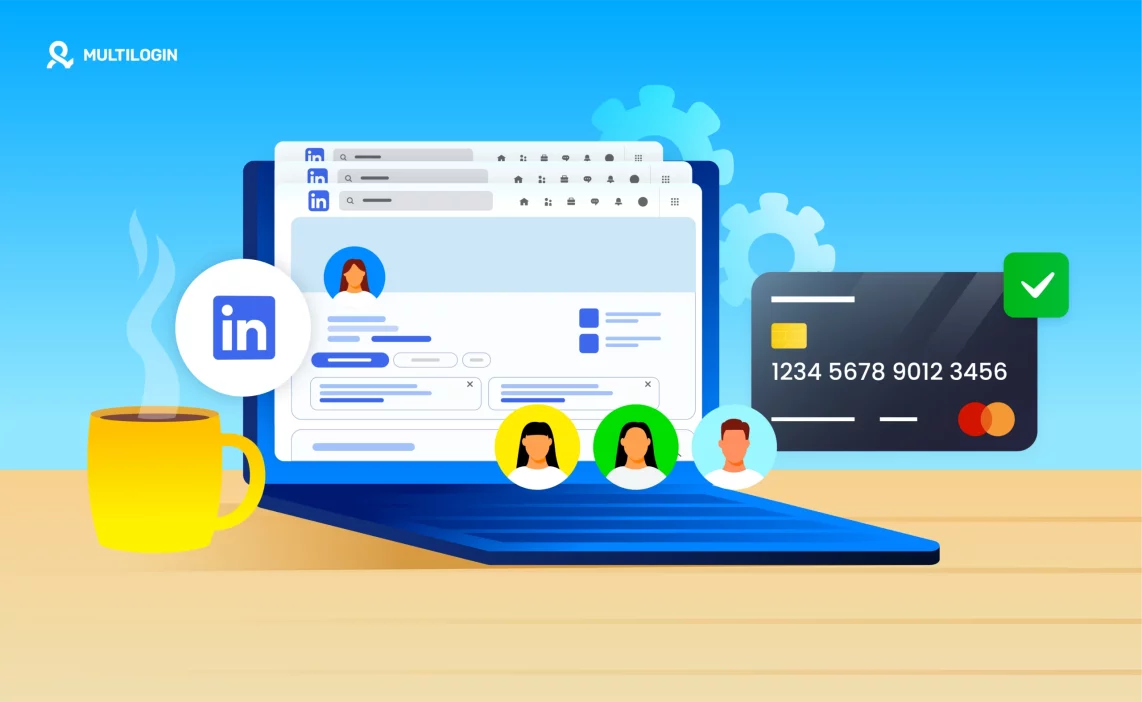Buying aged LinkedIn accounts can feel like a fast lane to outreach and growth — but it’s a lane full of potholes. This guide breaks down when buying makes sense, what to watch out for, and how to manage risks so you don’t lose your main profile or reputation.
In this article, we:
- Explain the real benefits of aged LinkedIn accounts (trust, deliverability, speed).
- Outline the major legal, ethical, and security risks.
- Show how to pick a safer seller and what quality checks to run.
- Give practical steps to onboard, scale, and monitor multiple accounts.
- Summarize smart alternatives and long-term strategies for LinkedIn growth.
Why aged accounts feel like a cheat code
Older profiles have everything LinkedIn’s algorithm loves: creation dates stretching back years, natural activity history, and connection patterns that look human. LinkedIn’s verification systems treat seasoned accounts like VIPs at the velvet rope. Your connection requests sail through. Your InMails land in the primary tab. No probation period while the algorithm decides if you’re worth trusting.
Ever notice how some profiles get throttled while others don’t? Aged accounts bypass the spam filter lottery. Your outreach lands where it should instead of vanishing into LinkedIn’s junk drawer.
Agencies running multi-account campaigns can’t afford to sit around aging profiles like fine wine. Aged accounts let you launch ten profiles on Monday instead of waiting six months for them to mature. Time is leverage, and aged accounts hand it to you.
The fine print: Not all aged accounts are created equal
Buying aged accounts only works if you’re not grabbing recycled junk off a sketchy marketplace. LinkedIn’s detection systems track behavior patterns, IP consistency, device fingerprints, and login rhythms. Slap a brand-new automation script onto a five-year-old account with mismatched activity, and you’ve basically waved a red flag at a bull.
Quality matters. A lot. If the account logged in from Brazil yesterday and suddenly starts prospecting SaaS leads from Denver today, LinkedIn notices. When LinkedIn notices, your expensive shortcut becomes an expensive brick.
So is it worth it?
Growth teams, agencies, and anyone running campaigns at volume have already figured this out. Aged accounts give you infrastructure that works if you pair it with the right tools: unique browser fingerprints, clean IPs, realistic activity patterns, and account management that doesn’t set off alarms.
Use them smart, manage them clean, and they’ll do exactly what you bought them for: get you in the door before LinkedIn even thinks to ask questions. Cut corners, and even the oldest account in the marketplace won’t save you from a ban.
Learn more about buying aged Facebook accounts and the risks to watch for in our article.
The risks of buying LinkedIn accounts
Buying LinkedIn accounts feels like a growth hack until it blows up in your face. LinkedIn’s detection systems have gotten scary good, and the fallout from getting caught can torch more than just the account you bought. We’re talking about real damage: lost networks, burned reputations, and bans that stick forever.
Your main account becomes collateral damage
LinkedIn doesn’t just flag the sketchy account you bought. If it sniffs out any connection between your purchased profiles and your main account—shared devices, overlapping cookies, matching login environments—everything gets torched at once.
What that looks like: Your main account, the one with years of real connections and conversations, gets restricted or suspended. Your professional network evaporates overnight. Business leads, ongoing conversations, partnership threads—all gone. And good luck explaining to your boss or clients why you suddenly can’t access LinkedIn.
Your credibility takes a permanent hit
LinkedIn runs on trust and transparency. Getting caught with fake or purchased profiles doesn’t just break platform rules—it breaks the one currency that actually matters in professional networking: your reputation.
What that looks like: Clients, partners, and employers lose faith. Your brand image craters. Rebuilding trust on a platform where authenticity is the baseline becomes nearly impossible. People remember, and LinkedIn makes sure the internet does too.
Fake engagement is just noise
Purchased profiles might have follower counts and connection lists but dig deeper, and you’ll find ghost towns. Irrelevant networks, inactive connections, and engagement rates that barely register. You’re paying for the illusion of reach, not reality.
What that looks like: Your content gets no traction. Outreach campaigns fall flat. Lead generation sputters because the people “connected” to your purchased account never asked to be there and don’t care about what you’re selling. You’ve bought a megaphone with no one listening.
Ethical and legal landmines everywhere
Buying accounts violates LinkedIn’s User Agreement, full stop. But it got worse. Depending on where the accounts came from, you might be trafficking in stolen personal information or data scraped without consent. That puts you on the wrong side of GDPR, CCPA, and a pile of other data protection laws you don’t want to mess with.
What that looks like: Legal exposure that goes beyond platform bans. Ethical damage that sticks to your brand or agency. And a high chance you’re dealing with fraudulent sellers who disappear the moment something goes wrong.
Your data is up for grabs
Many aged accounts get traded through shady marketplaces where login credentials are recycled, resold, or kept by the seller. You think you own the account, but someone else might still have the keys.
What that looks like: Accounts get hijacked after you’ve invested time and money. Your messages, contacts, and personal data get exposed. Sellers use your account for phishing or identity theft, and you’re left holding the bag.
Bans are swift, permanent, and ruthless
LinkedIn’s algorithms flag purchased accounts fast. Inconsistent IPs, abnormal activity spikes, mismatched device fingerprints—the moment the pattern looks off, the hammer drops. And when LinkedIn bans you, there’s no appeal process, no second chances, no refunds from the seller.
What that looks like: Permanent account loss with zero recovery options. Related browser fingerprints or IPs get blacklisted, making it harder to operate even with legitimate accounts. The investment turns into a total write-off.
The bottom line
If you’re going to manage multiple or purchased LinkedIn accounts, you need dedicated tools that isolate each profile’s digital fingerprint. Without that layer of protection, you’re playing Russian roulette with your entire LinkedIn operation. One slip, and the platform takes everything.
How to reduce the risk of bans of your multiple LinkedIn accounts
Multilogin is a reliable antidetect browser that isolates each LinkedIn account in a separate browser environment—complete with unique fingerprints, cookies, and local settings. This prevents LinkedIn from recognizing that multiple profiles are being managed from the same device or network.
Key Benefits for LinkedIn Account Management:
- Account isolation: Each LinkedIn profile runs in its own browser environment with a unique fingerprint and local storage, eliminating cross-detection risks.
- Built-in proxies: Assign country-specific proxies to each account directly inside Multilogin — no external proxy providers required.
- Beginner-friendly interface: Simple and intuitive UI makes setup and daily account management straightforward.
- Automation support: Works smoothly with tools like Puppeteer, Selenium, and Postman for outreach, messaging, and data collection workflows.
- Affordable pricing: Start with a 3-day trial for only €1.99, then choose from flexible plans starting at €9/month.
- 24/7 expert support: Available in 5 languages to assist with configuration and scaling.
Multilogin allows you to create and manage multiple LinkedIn accounts—whether for lead generation, recruiting, or marketing—while maintaining complete separation, stability, and compliance.
For detailed setup and isolation best practices, read our guide on managing multiple LinkedIn accounts.
How legal is to buy LinkedIn accounts
Buying LinkedIn accounts violates LinkedIn’s User Agreement and has clear, real-world precedents showing the risks. Users frequently report on forums like Reddit that purchased or transferred accounts are quickly flagged, restricted, or permanently banned, often with little ability to recover the profile.
Courts and high-profile cases about unauthorized scraping and platform enforcement have affirmed platforms’ rights to block abusive access and enforce their terms. Because of these precedents, buying accounts is effectively a gamble: you can lose purchased profiles, risk suspension of your main account if links are detected, and face reputational or legal exposure if accounts were created or transferred using someone else’s data.
In short: you are buying accounts at your own risk, and no one can guarantee the safety of these accounts.
Concerned about shadow banning? See our article for practical steps to detect and recover from LinkedIn shadow bans.
How to choose a trusted account store
The LinkedIn account market is a mixed bag. Legitimate sellers exist, but so do fly-by-night vendors peddling recycled junk that’ll get flagged in a week. Choosing the right provider determines whether your investment pays off or turns into an expensive lesson in what not to do.
What to look for before you buy:
- Reputation and reviews. Dig into independent review sites, forums, and social media before you hand over a dollar. Look for providers with consistent positive feedback and a track record you can verify. If the reviews feel fake, the seller probably is too. And if the offer looks suspiciously cheap compared to everyone else, there’s a reason—and it’s not generosity.
- Account quality. Not all aged accounts are built the same. Ask how old the account is, how many real connections it has, and whether it’s phone-verified. Older accounts with genuine activity and PVA status stand a better chance of flying under LinkedIn’s radar. Freshly scraped profiles with zero history? Those are ticking time bombs.
- Transparency. Good providers don’t hide behind vague descriptions and one-line FAQs. They explain their processes, lay out pricing clearly, and don’t sugarcoat the risks. They answer questions about how accounts were created, how they’re verified, and what kind of management practices keep them safe. If a seller dodges your questions or talks in circles, walk away.
- Customer support. Problems happen. Accounts get restricted. Login issues pop up. Technical glitches kill your workflow. You need a provider who responds when things go sideways, not one who ghosts you the moment the transaction clears. Test their support before you buy—send a question, see how fast and how well they respond.
- Replacement policies. Accounts can get banned despite your best efforts, especially in the first few weeks. Reputable sellers offer replacement guarantees for accounts that get flagged shortly after purchase. If a provider won’t stand behind their product, that’s a red flag the size of a billboard.
- Security measures. Ask if the provider recommends anti-detect browsers, dedicated IPs, or account isolation techniques. Sellers who understand fingerprinting, session management, and safe operating practices are the ones who’ve been in the game long enough to know what works. If they have no advice on how to keep accounts safe after purchase, they’re not thinking past the sale.
- Payment options. Stick with providers who offer secure, traceable payment methods. Credit cards, PayPal, verified crypto—anything that leaves a paper trail. Vendors who only accept anonymous or untraceable payments are making it easy for themselves to disappear when things go wrong. That should make you nervous.
The takeaway
Buying LinkedIn accounts always carries risk, but choosing the right provider dramatically improves your odds. The difference between a reliable account and a banned one often comes down to who you bought it from.
Top platforms to buy LinkedIn accounts in 2025
Based on extensive research and analysis of current market offerings, here is a curated list of platforms where you can consider purchasing LinkedIn accounts.
This list combines providers from our reference articles with additional findings, offering a comprehensive overview. It is crucial to conduct your own due diligence before making a purchase.
1. MirrorProfiles
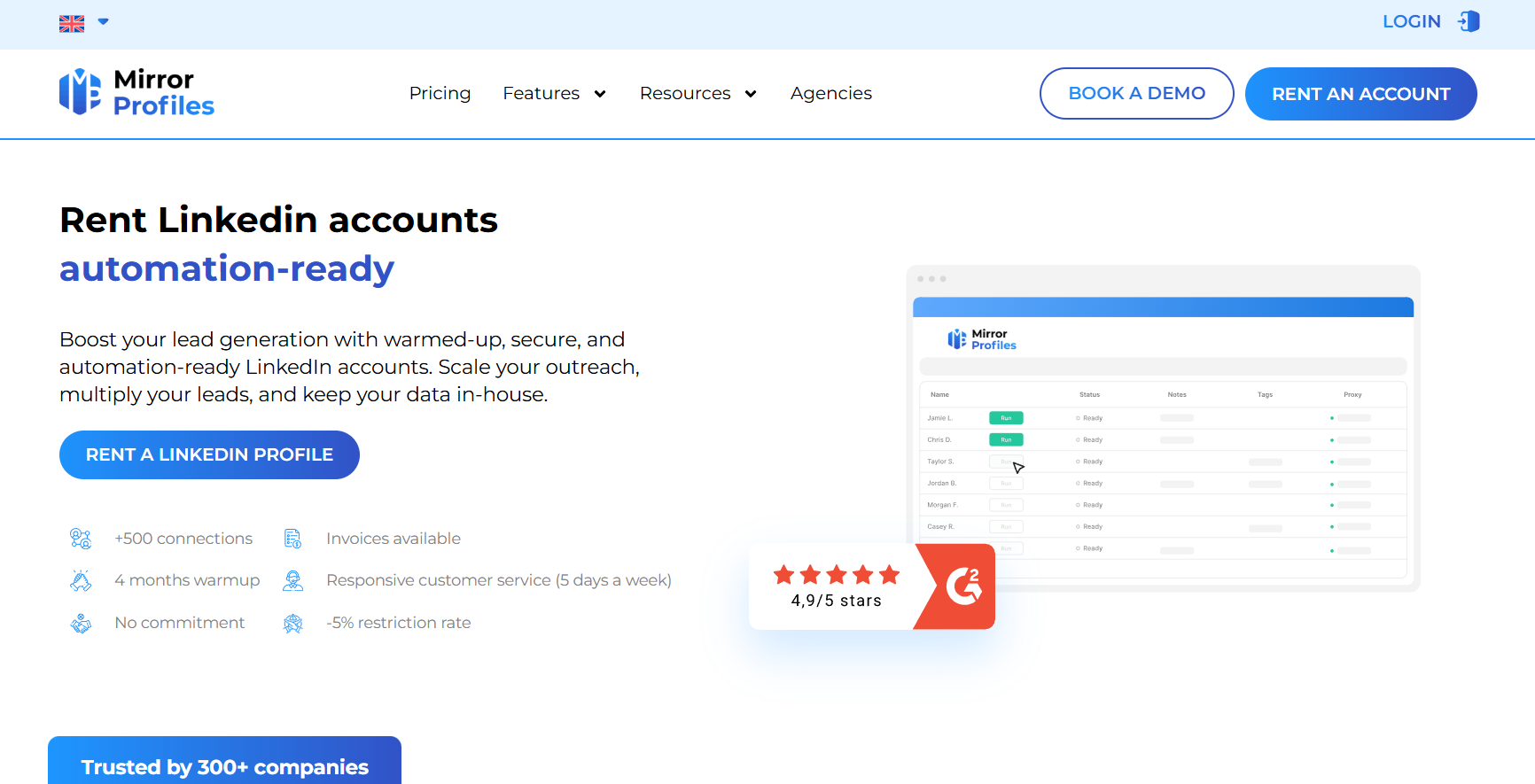
MirrorProfiles is frequently cited as a top-tier service for renting LinkedIn accounts. They specialize in providing high-quality, warmed-up accounts with a significant number of real connections (500+). Their key strength lies in compatibility with major LinkedIn automation tools and robust safety features.
Pros:
- LinkedIn-specific service, indicating specialized expertise.
- High-quality, aged accounts with real connections.
- Managed digital fingerprints and dedicated country IPs for enhanced security.
- Good support and clear pricing structure.
- Native integration with anti-detect browsers
Cons:
- Higher price point compared to some competitors (starting from EUR 130/month).
- Primarily offers account rental rather than outright purchase.
User reviews: Mixed. While some users praise the platform for high-quality accounts and efficient setup, others express concerns about a steep learning curve and limited customization options.
2. LinkUnity
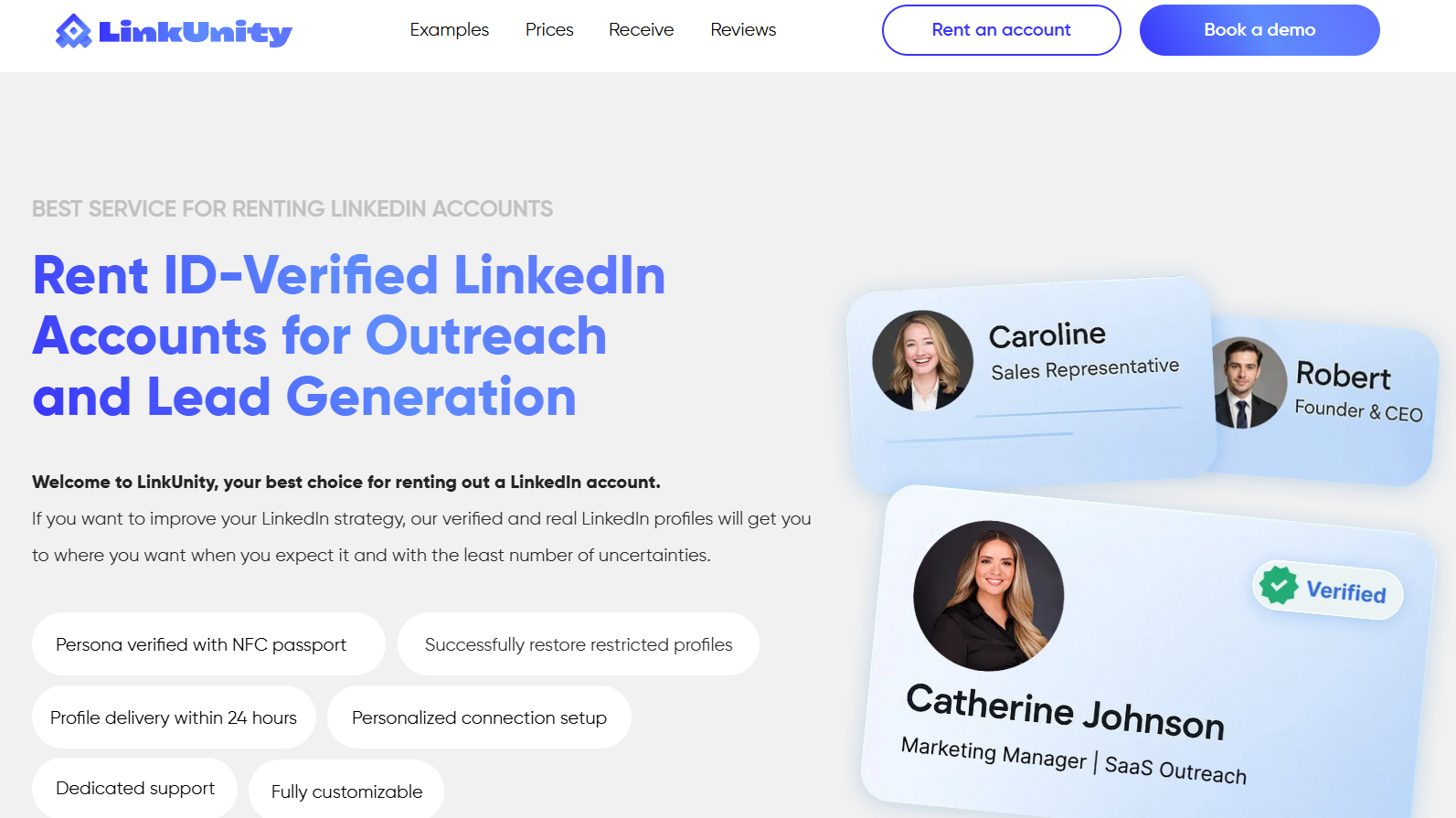
LinkUnity is recognized as a reliable supplier of verified and aged LinkedIn accounts. They emphasize account quality and compatibility with popular LinkedIn automation tools. They also highlight a strong focus on account personal verification.
Pros:
- Trusted vendor with high account quality.
- Account persona verified with NFC passport, adding a layer of authenticity.
- Ability to restore restricted profiles.
- Profile delivery typically within 24 hours.
- Loyalty system for long-term clients.
Cons:
- Account stock and delivery times can fluctuate based on demand.
- Not the cheapest option, though compensated by quality and features.
User reviews: Mostly positive. Customers commend the service for providing aged, verified LinkedIn profiles with full control over messaging and interactions, leading to safer and more effective outreach.
3. UseViral
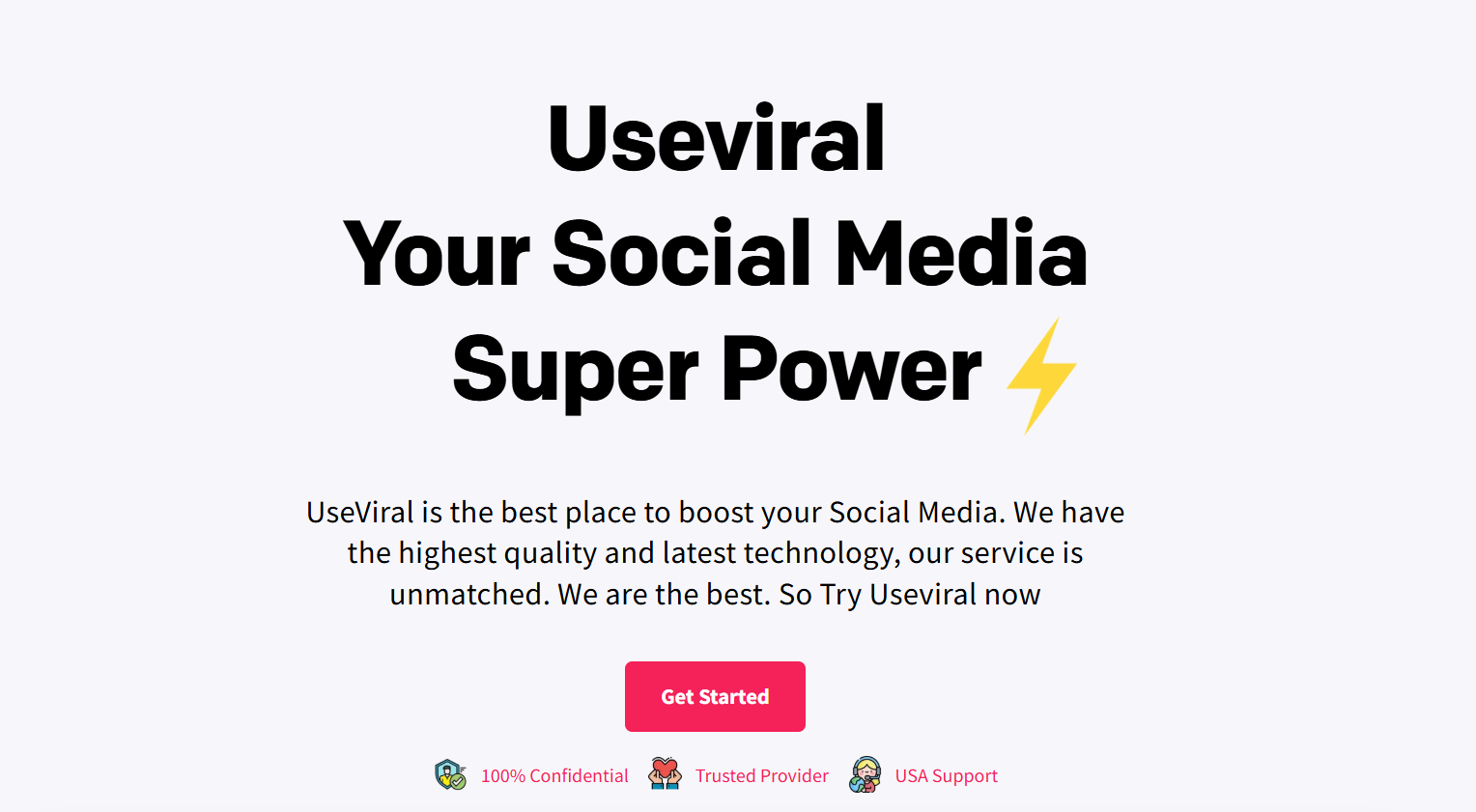
UseViral is a prominent name in social media growth services, extending its offerings to LinkedIn accounts, followers, and engagement. They aim to provide high-quality, real-looking accounts and organic growth strategies.
Pros:
- Wide range of social media services available.
- Generally positive user reviews.
- Offers various packages to suit different budgets.
- Claims to provide gradual, natural-looking growth.
Cons:
- The quality of accounts can sometimes vary.
- Some users have reported slow delivery times.
- Customer support experiences can be inconsistent.
User reviews: Mostly negative. Reviews indicate dissatisfaction with the service, citing issues such as rapid follower drops and unresponsive customer support.
4. Akountify
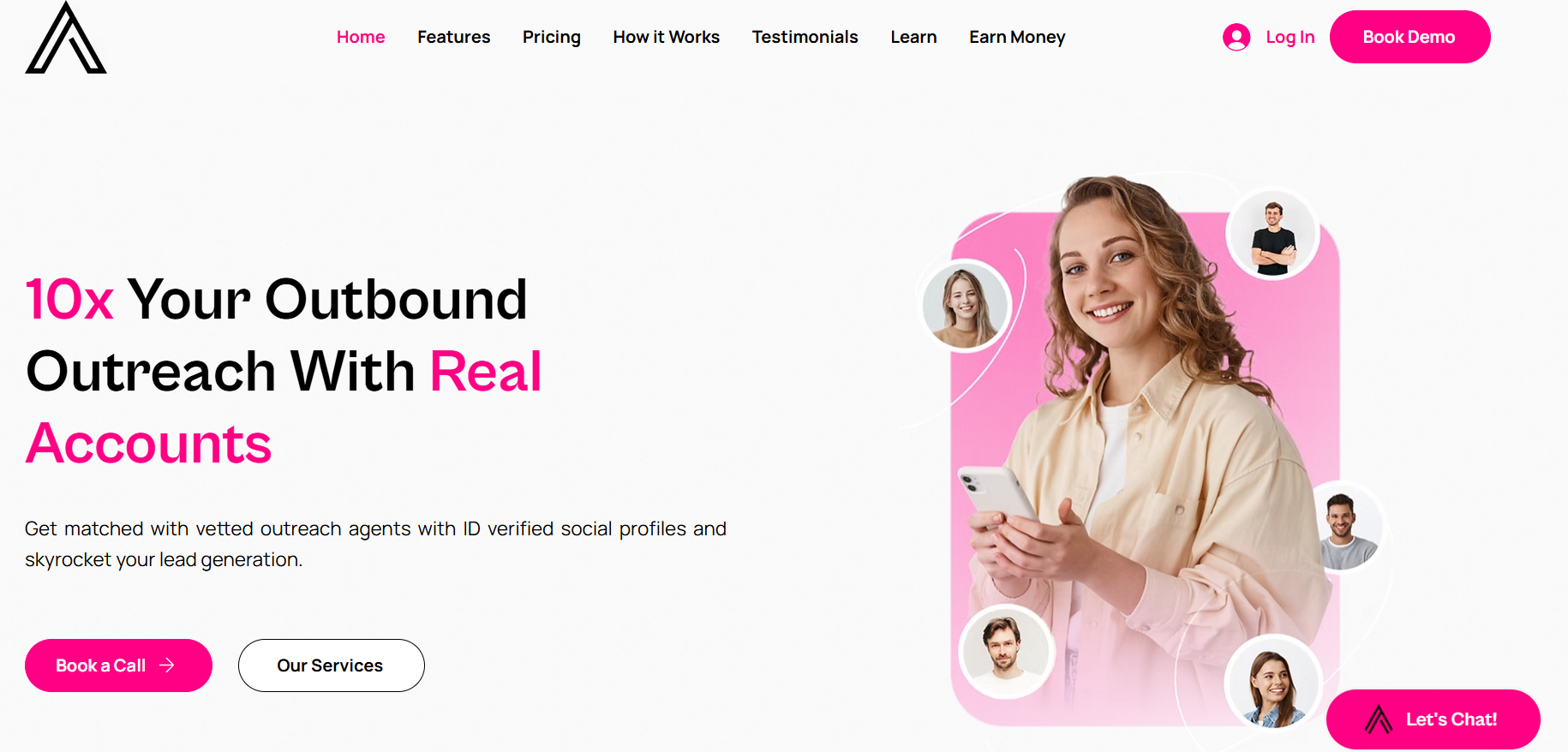
Akountify distinguishes itself by claiming to provide real LinkedIn accounts backed by real people, which is a more ethical approach than simply farmed accounts. They focus exclusively on LinkedIn, catering to lead generation firms.
Pros:
- LinkedIn-only focus suggests higher specialization and quality.
- Real person-verified accounts, reducing the risk of account loss.
- Good customer support and guarantees.
- Offers automation tool seats (HeyReach and Skylead).
Cons:
- Expensive pricing.
- Primarily offers account rental.
User reviews: Mixed. Some users report positive experiences with reliable services and responsive support, while others caution about potential risks and lack of transparency.
5. SidesMedia
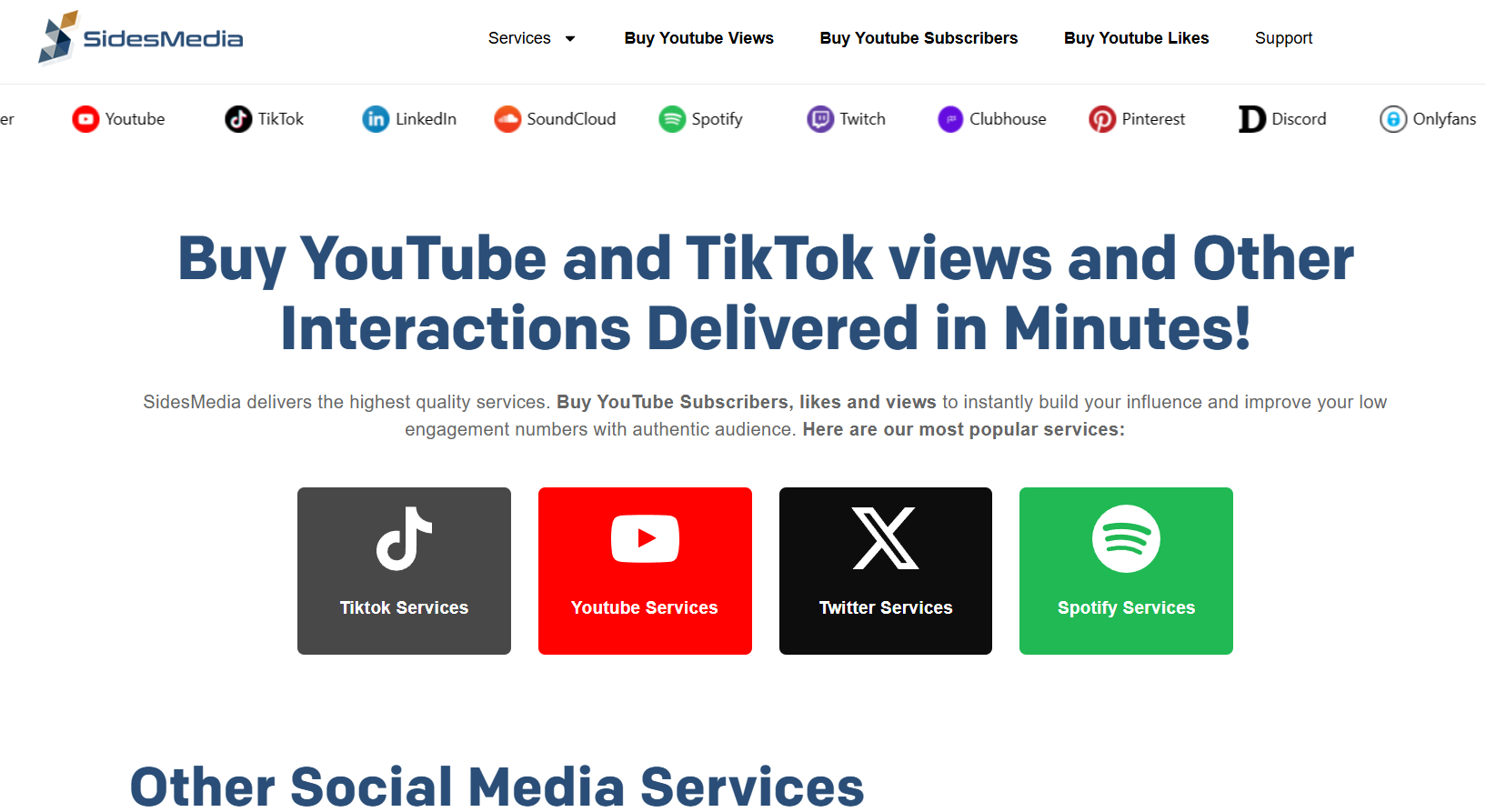
SidesMedia focuses on organic growth services across multiple social media platforms, including LinkedIn. They offer account sales and engagement boosting, with an emphasis on natural growth.
Pros:
- Claims to provide high-quality, real-looking accounts.
- Offers gradual growth to maintain a natural appearance.
- Positive reputation for customer service.
- Clear and reasonable pricing.
Cons:
- Quality can be unknown without prior experience.
- Caution advised regarding random comment purchases, which can be risky.
User reviews: Neutral. Sentiment is mixed, with a general reputation for social media growth services but a lack of independent LinkedIn account reviews.
6. Growthoid
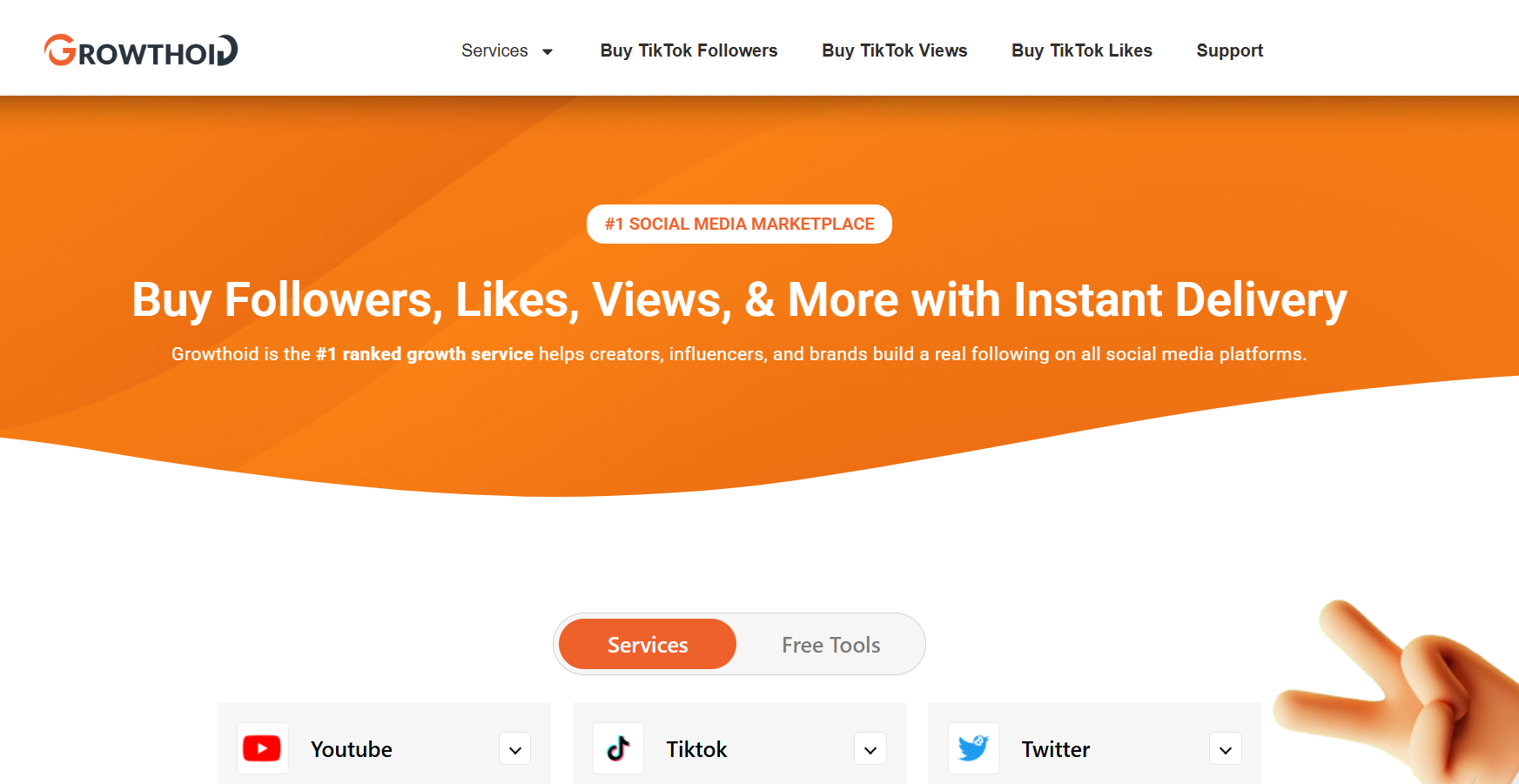
Initially known for Instagram growth, Growthoid has expanded into LinkedIn, offering account management and growth services. They focus on personalized strategies and targeted growth.
Pros:
- Experienced in broader social media growth strategies.
- Offers personalized account management.
- Claims to use targeted growth techniques.
Cons:
- More focused on growth services than direct account sales.
- Higher price point.
- May not be suitable for those seeking immediate results.
User reviews:Mixed. While some users appreciate the quality of accounts and customer support, others report issues with follower retention and delivery guarantees.
7. Twesocial
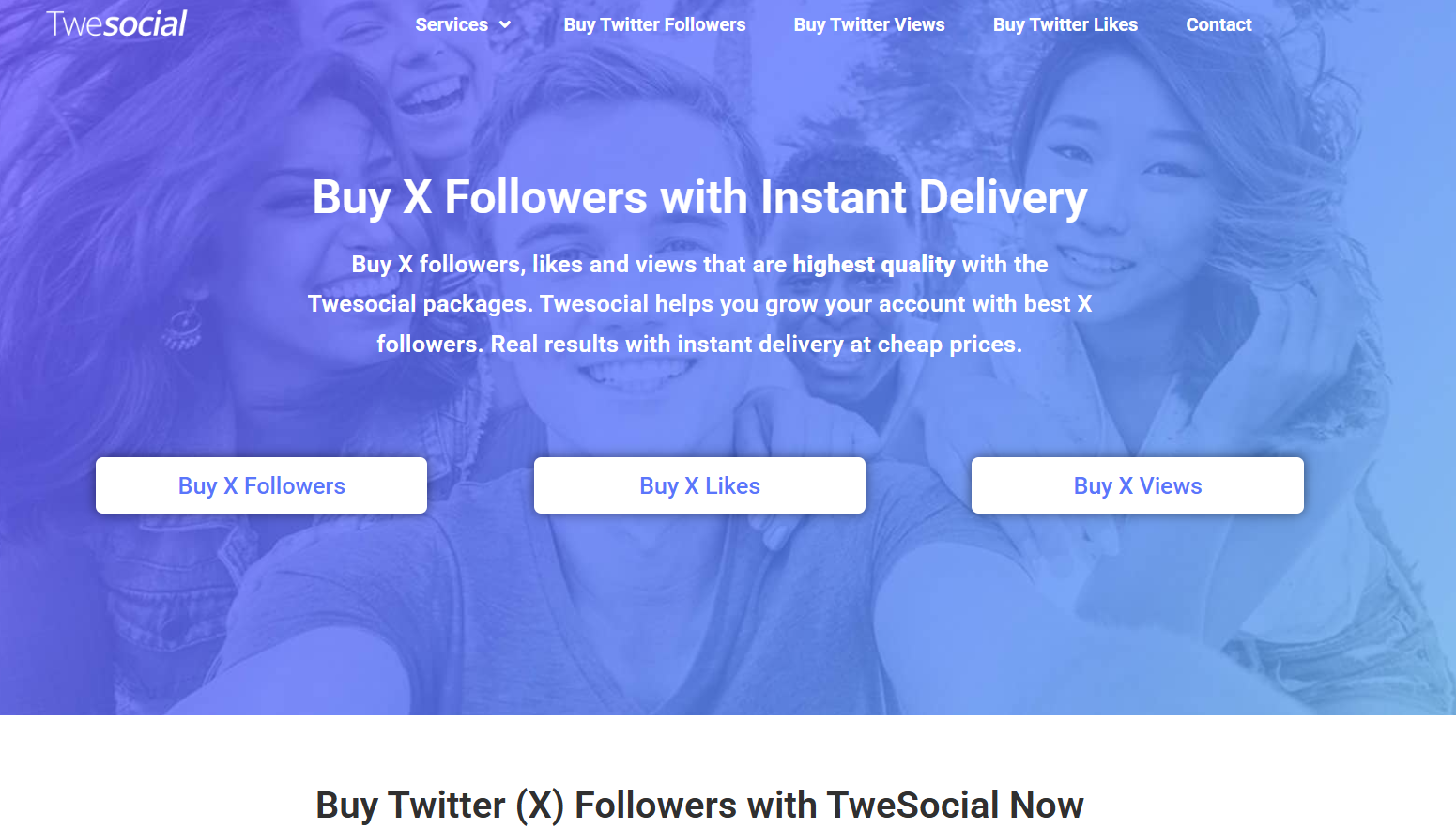
While primarily a Twitter service, Twesocial has diversified to include LinkedIn solutions, offering account sales and engagement boosting. They provide both manual and automated growth options.
Pros:
- Universal service offering for various platforms.
- Reasonable pricing.
- Offers both manual and automated growth options.
Cons:
- LinkedIn services are newer and may be less developed.
- Limited track record specifically for LinkedIn.
- Some users have reported inconsistent results.
User reviews: Mixed. Some users praise the service for effective Twitter growth and quality support, while others report issues with billing practices and account setup.
8. TokUpgrade
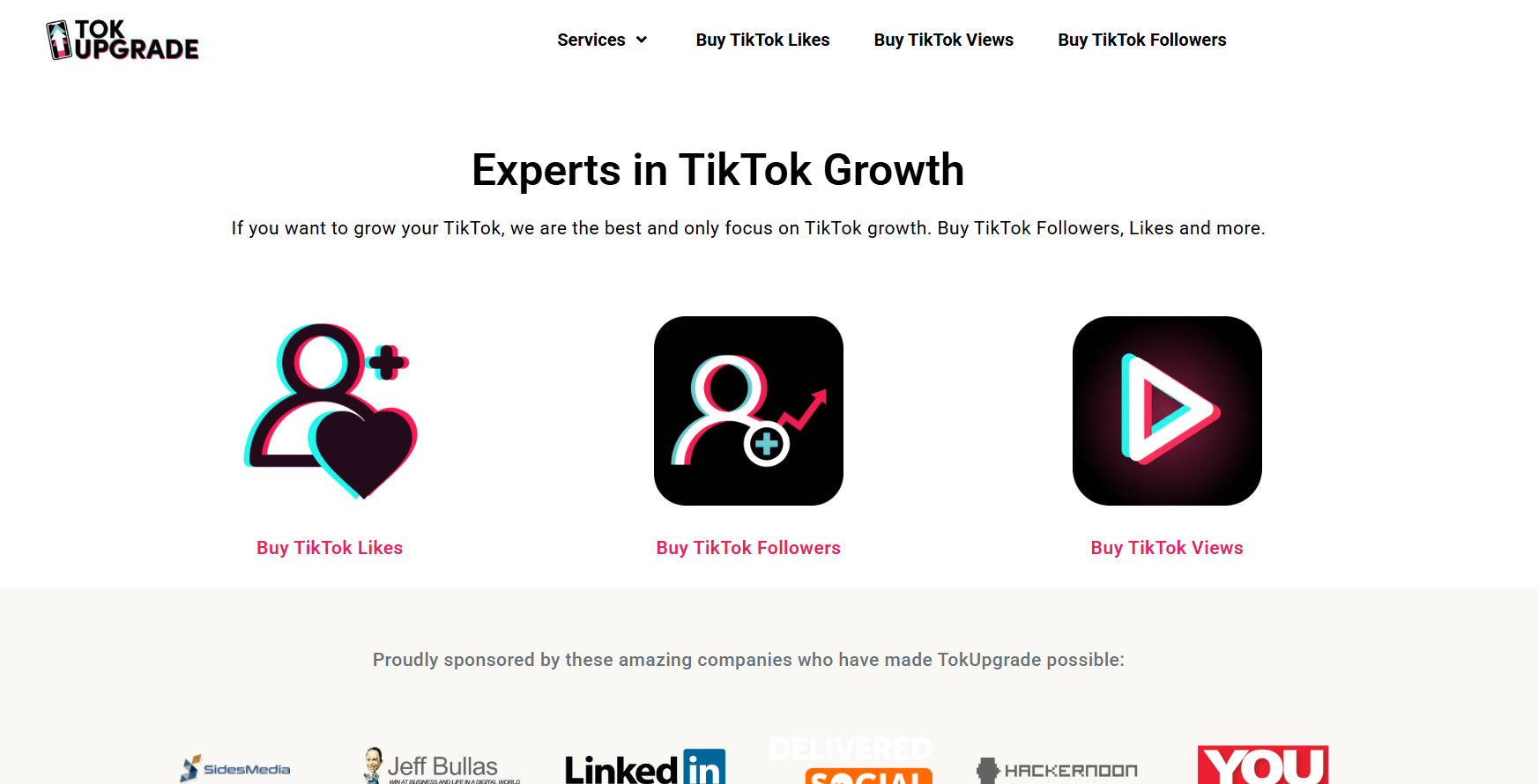
Similar to Twesocial, TokUpgrade started with TikTok but now offers universal account sales and growth services for platforms like LinkedIn. They emphasize targeted growth strategies.
Pros:
- Universal service across multiple platforms.
- Offers targeted growth strategies.
- Reported good customer support.
Cons:
- Relatively new to LinkedIn services.
- Higher prices for premium services.
- Limited options for bulk account purchases.
User reviews: Neutral. Reviews are generally positive for TikTok services; LinkedIn accounts are a secondary service claiming authentic growth.
9. True Accs (formerly BuyAccs)
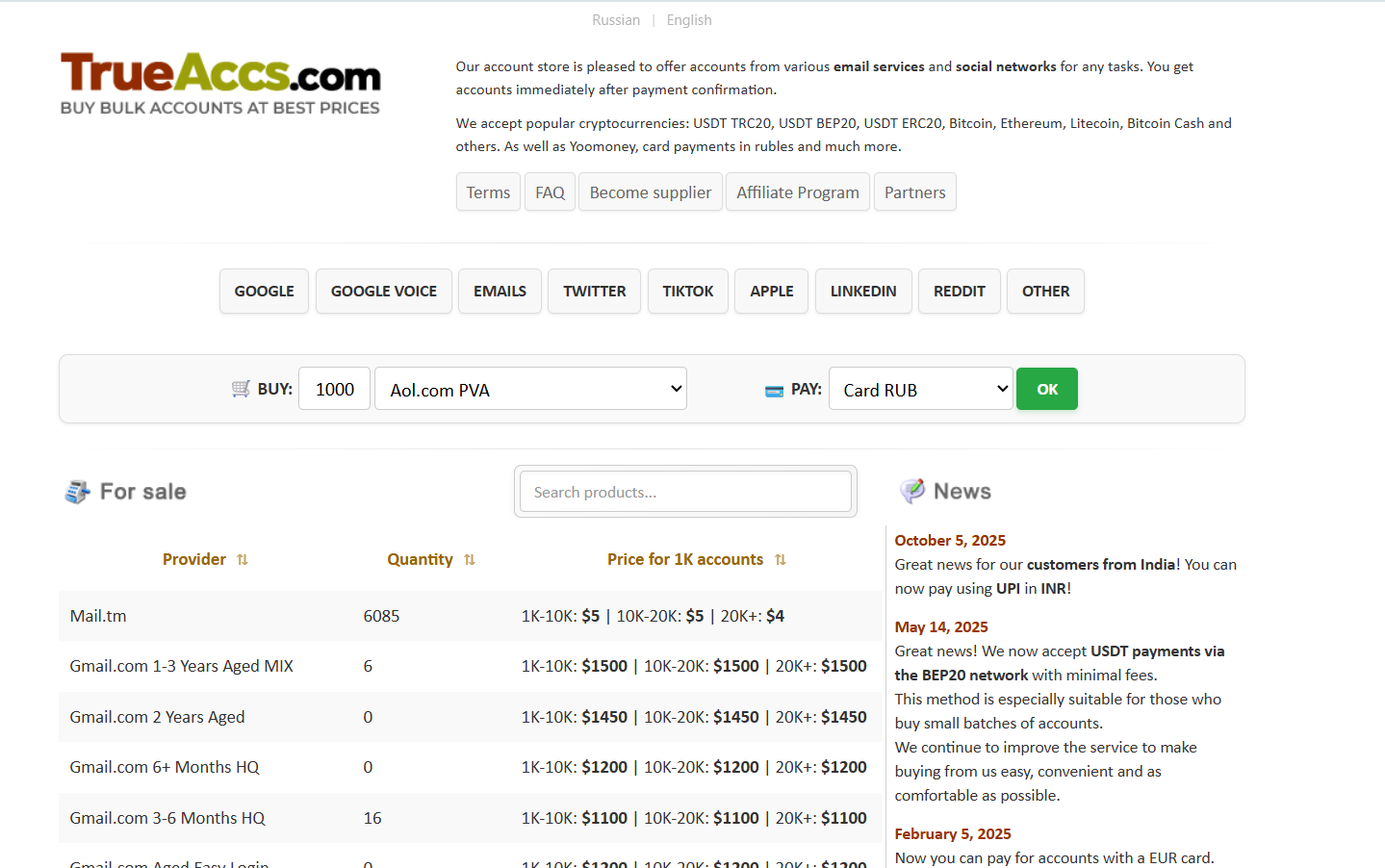
True Accs, also known as BuyAccs, appears to be a service specializing in bulk account sales for various social media platforms, including LinkedIn. They focus on providing fresh bulk accounts.
Pros:
- Wide variety of account types available.
- Options for bulk purchases.
Cons:
- Quality can be inconsistent.
- Vendor reputation may be unknown.
- Limited after-sales support.
- Some users have reported accounts being banned shortly after purchase.
User reviews: Mixed. While some users find the service reliable for bulk account purchases, others report issues with account quality and customer support.
10. SocLikes
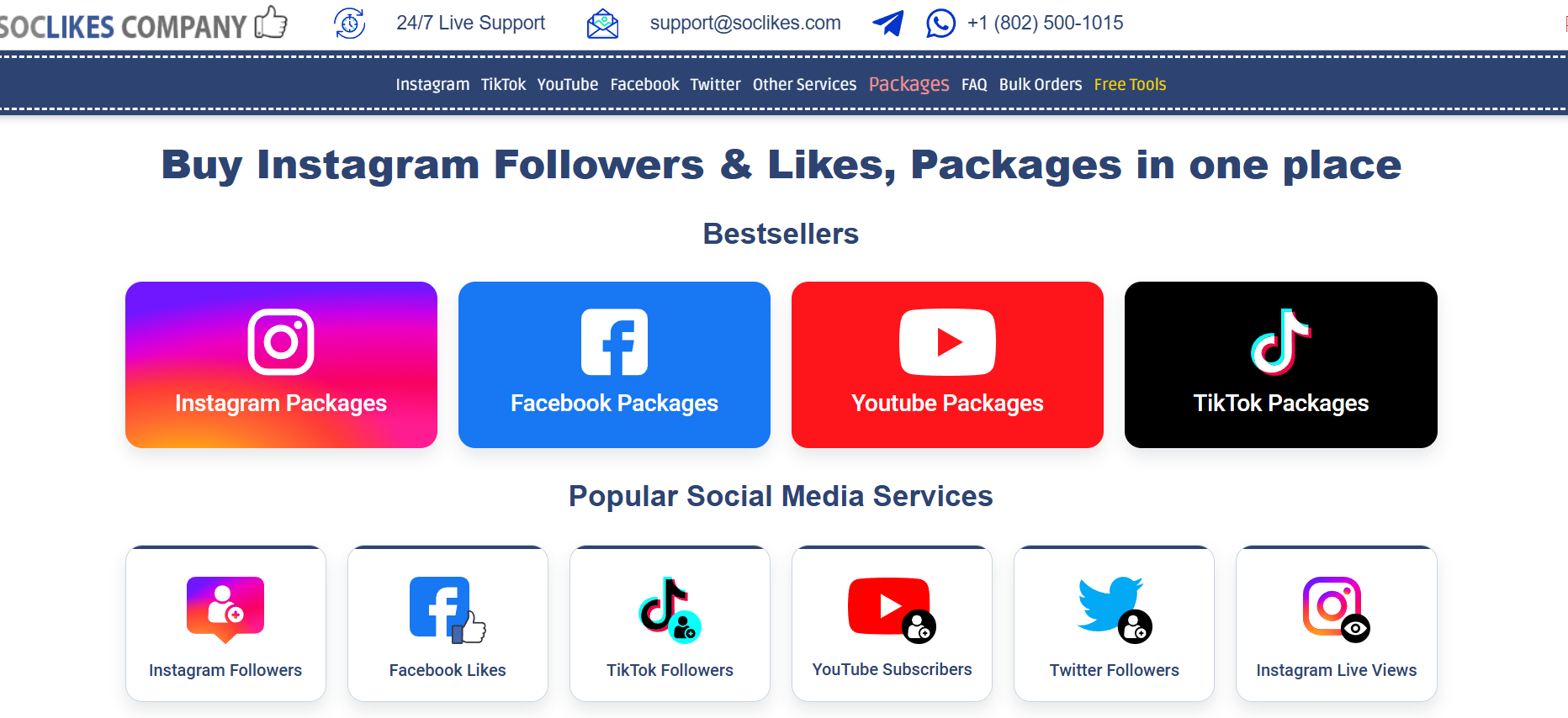
SocLikes is a universal social media service offering LinkedIn account sales alongside other services. They provide different types of accounts, including new and aged ones.
Pros:
- Offers both new and aged LinkedIn accounts.
- Competitive pricing, especially for bulk orders.
- Reported quick delivery times.
Cons:
- Account quality can be inconsistent.
- Limited information about account origins.
- Customer support can sometimes be slow.
User reviews: Mostly positive. Users appreciate the low prices and 24/7 support, with some noting the platform’s high rating on review sites.
11. BulkAccountsBuy
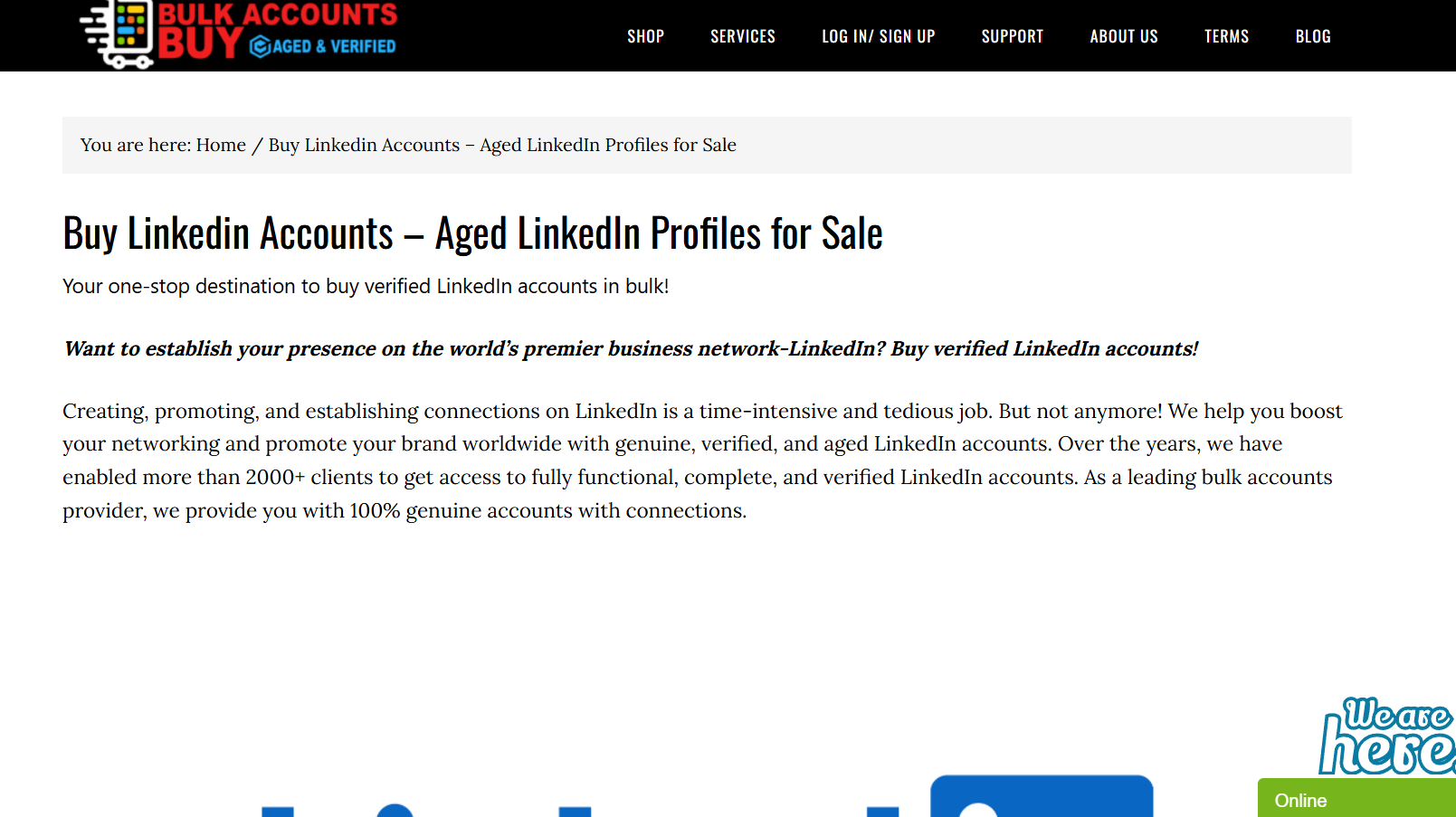
As its name suggests, BulkAccountsBuy specializes in selling accounts in bulk for platforms like LinkedIn. They are an established player catering to businesses needing multiple accounts.
Pros:
- Long-standing presence in the market.
- Reasonable pricing for bulk purchases.
- Offers both new and aged accounts.
Cons:
- Quality can vary significantly in bulk orders.
- Limited customization options.
User reviews: Mixed. The platform offers low prices for bulk orders, but quality can vary, leading to inconsistent user experiences.
12. BuySellAccounts
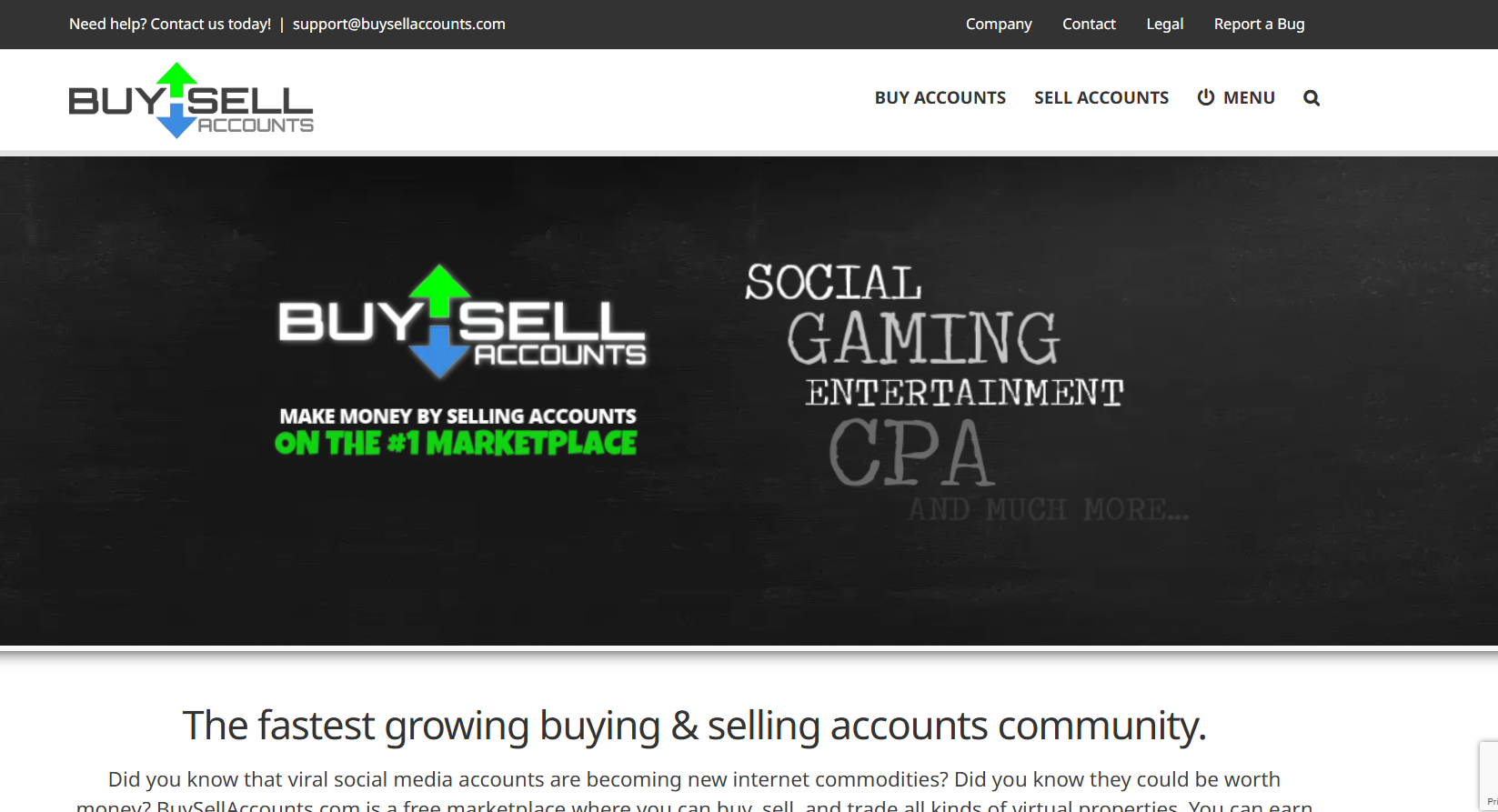
BuySellAccounts.com is another long-standing platform that facilitates the buying and selling of accounts for various platforms, including LinkedIn. They also offer domain names and unique usernames.
Pros:
- Universal service with a long market presence.
- Offers domain names and nicknames in addition to accounts.
Cons:
- Website may appear outdated and terms can be unclear.
- Pricing information is often not transparent.
User reviews: Mostly negative. The platform faces criticism for an outdated website, unclear terms, and lack of transparency in pricing.
13. Bulk PVA Shopz
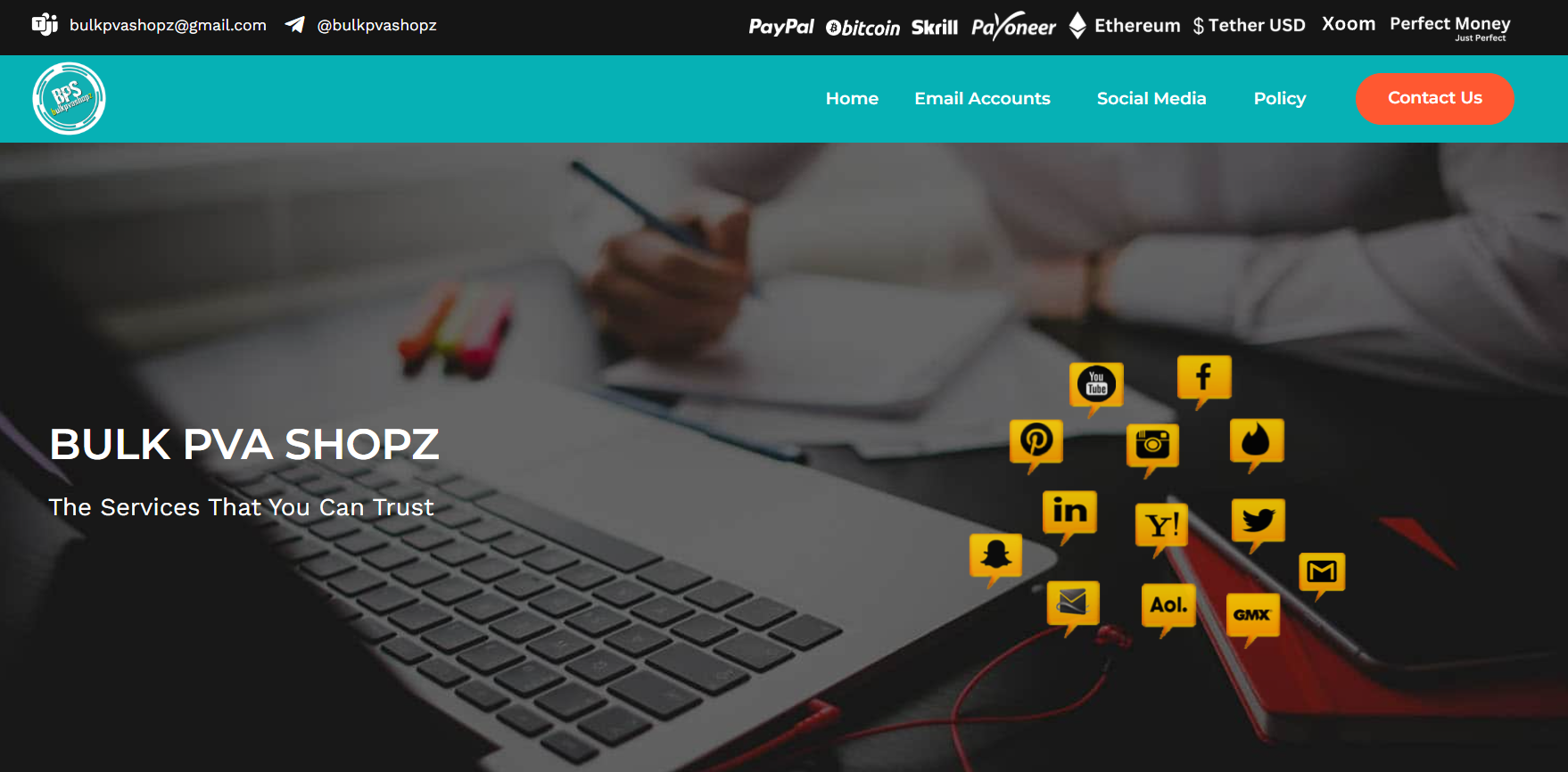
Bulk PVA Shopz focuses on providing phone-verified accounts (PVA) for multiple platforms, including LinkedIn. They emphasize accounts that have undergone additional verification steps.
Pros:
- Offers phone-verified accounts for added reliability.
- Bulk purchase options available.
- Competitive pricing for PVA accounts.
Cons:
- Limited customization options.
- Delivery times may be longer due to the verification process.
- Higher prices compared to non-PVA accounts.
User reviews: Mixed. The service provides Phone Verified Accounts (PVA), which offer added reliability against LinkedIn’s verification checks, though user experiences vary.
14. Accounts Provider
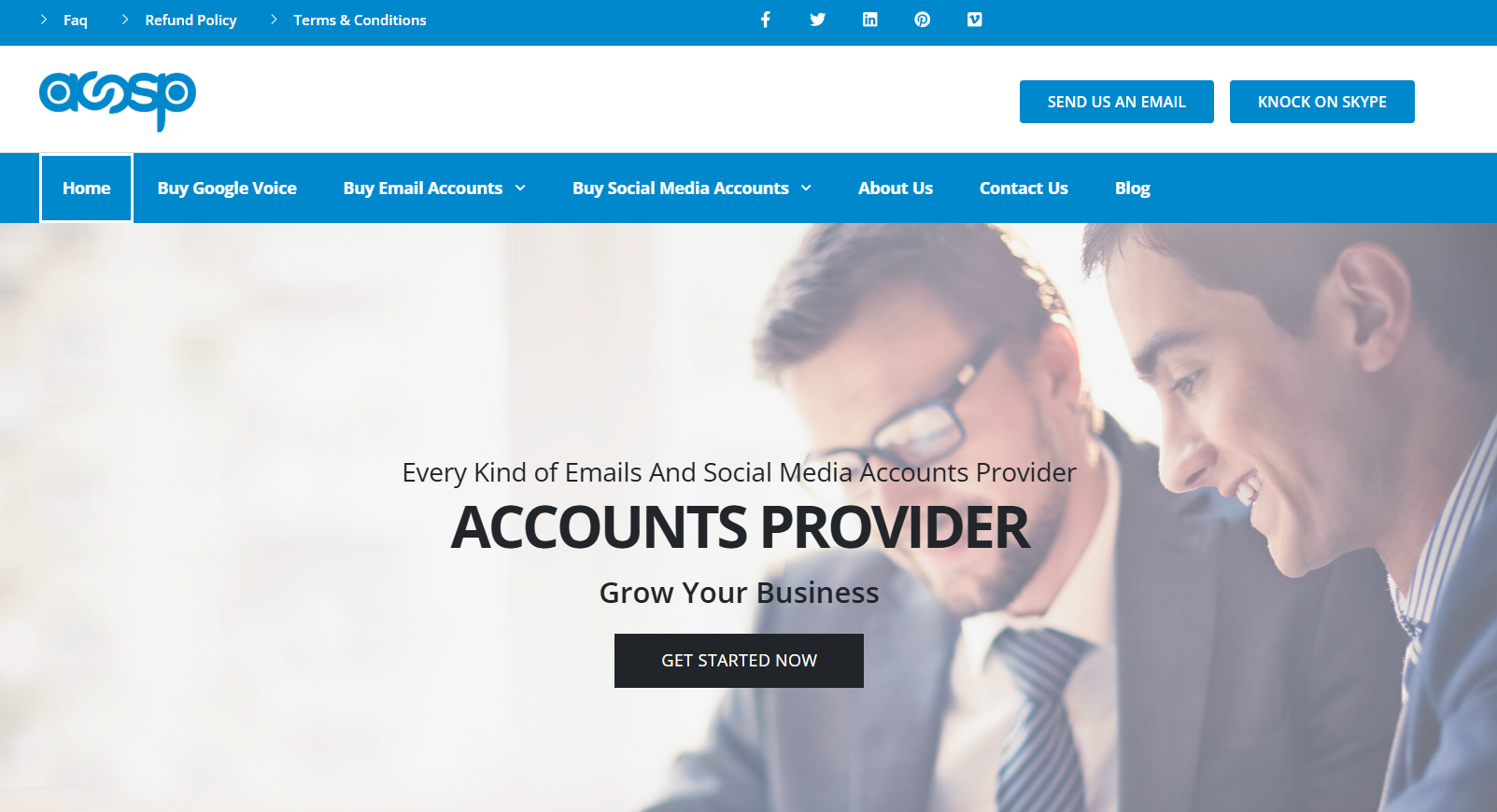
Accounts Provider aims to supply authentic social media accounts for business and marketing needs, covering a wide range of platforms, including LinkedIn. They claim to offer both verified and aged accounts.
Pros:
- Offers both individual and bulk account options.
- Claims to provide accounts with varying ages and qualities.
- Reasonable prices, with subscription options.
Cons:
- Website and service descriptions can sometimes be vague.
- Some users have reported inconsistent account quality.
User reviews: Mixed. The service offers aged accounts with a minimum of 250 connections, which is a key metric for many buyers, but user experiences vary.
15. VIPLikes
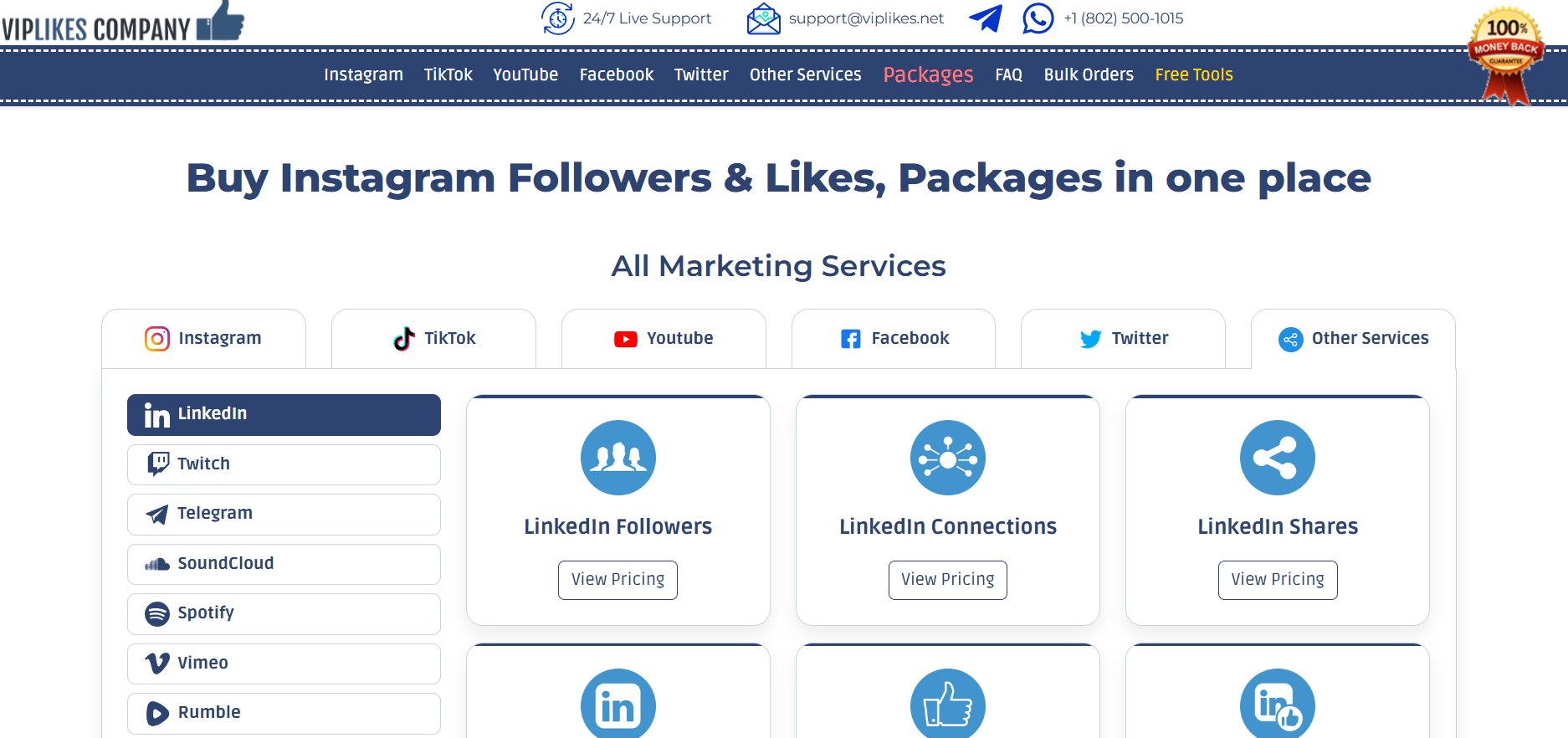
Similar to SocLikes, VIPLikes provides social media engagement services and also sells accounts for various platforms, including LinkedIn. They are known for competitive pricing and quick delivery.
Pros:
- Offers both account sales and engagement services.
- Competitive pricing for most services.
- Reported quick delivery times.
Cons:
- More focused on engagement than solely account quality.
- Limited information about account origins.
- Some users have reported difficulties with refunds.
User reviews: Mostly negative. Multiple users report that purchased accounts are quickly banned, often requiring replacements that also fail.
16. Woorke
Woorke is a well-known internet services provider that includes social media accounts, specifically LinkedIn, in its offerings. They are known for selling premium, aged, and fresh accounts created with unique IP addresses.
Pros:
- Sells premium social media accounts.
- Accounts created with unique IP addresses, enhancing safety.
- Offers various packages and bundles.
- 100% money-back guarantee.
Cons:
- Pricing can range significantly depending on the account type and features.
User reviews: Mostly negative. The platform has a low overall rating on independent review sites, with many customers reporting general dissatisfaction with their purchases.
17. Z2U
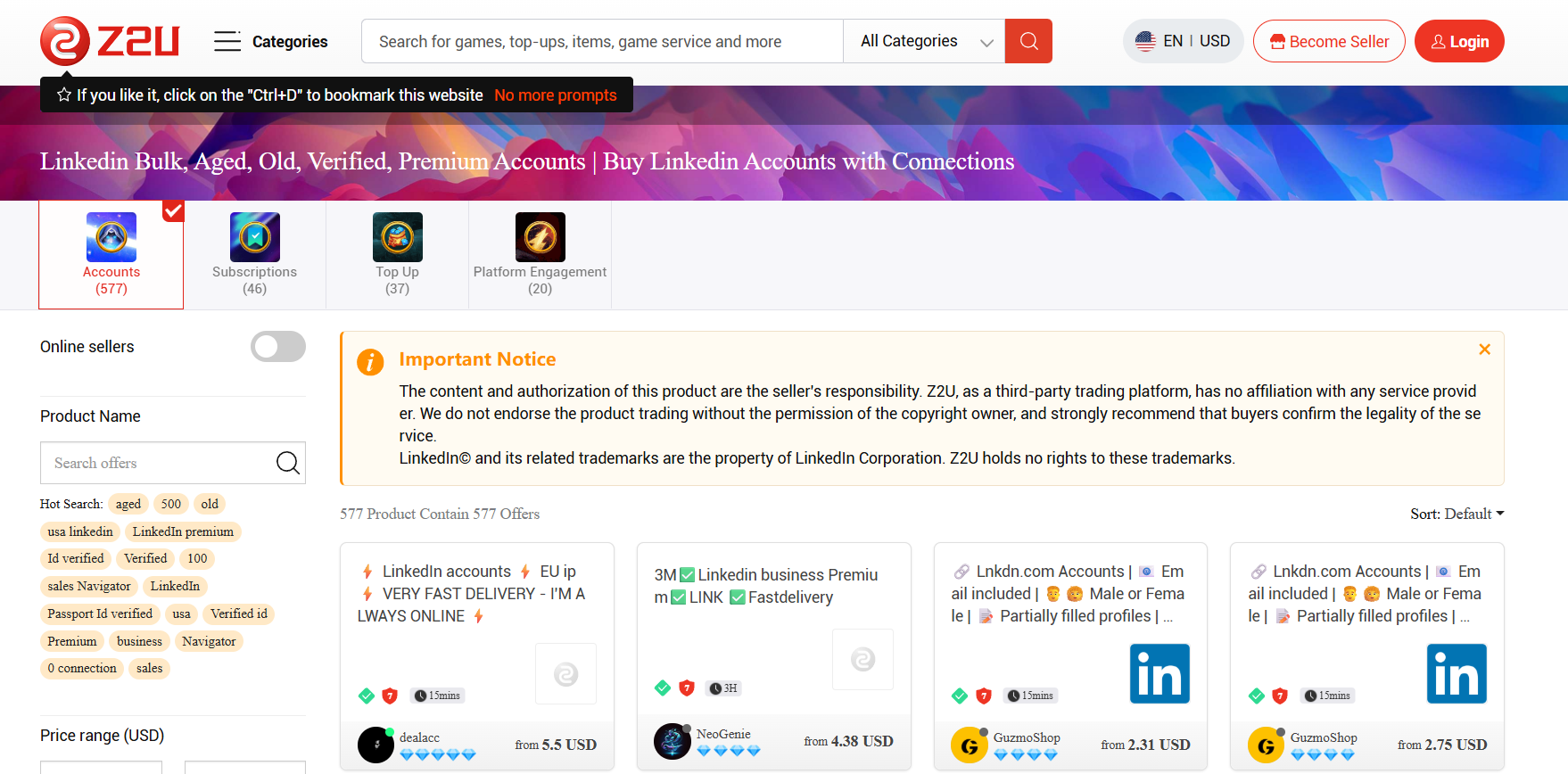
Z2U operates as a marketplace for digital goods, including a wide variety of LinkedIn accounts, from verified to aged and those with many connections. They act as an intermediary between buyers and sellers.
Pros:
- Wide variety of digital products, including diverse LinkedIn accounts.
- Buyer protection policies in place.
- Multiple secure payment options.
- Offers discounts for members.
Cons:
- Quality can vary greatly between sellers on the platform.
- Requires more research to identify reliable sellers.
User reviews: Mixed. As a digital marketplace, reviews indicate a wide variation in quality between sellers, necessitating buyer protection policies to manage risk.
18. ACCS Market
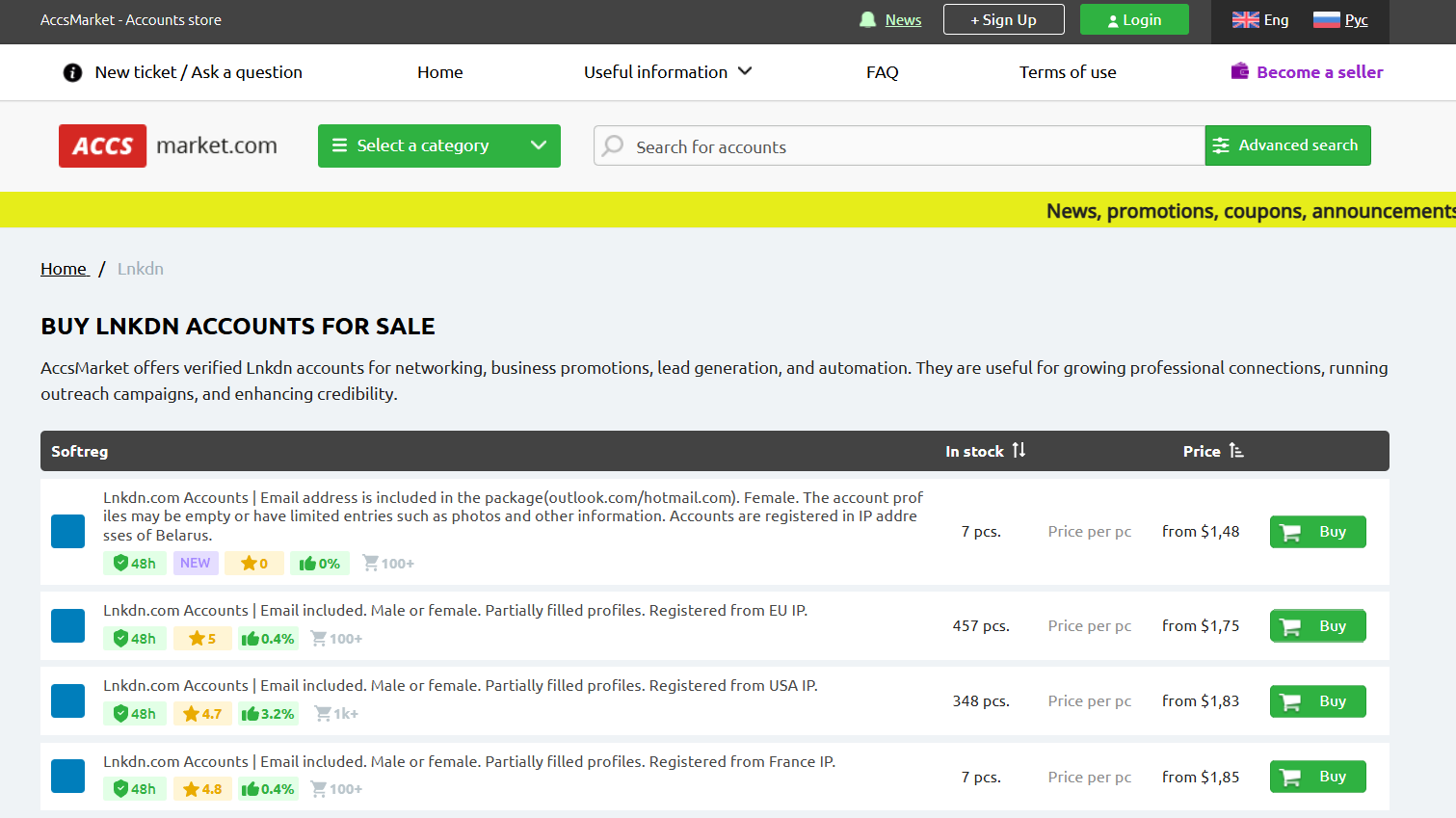
ACCS Market specializes in social media account sales across multiple platforms, including LinkedIn. They offer both individual and bulk options, with straightforward details on their webpage.
Pros:
- Reasonable pricing.
- Offers both individual and bulk account options.
- Claims to provide accounts of varying ages and qualities.
Cons:
- Limited information about account origins.
- Unknown quality without direct experience.
- Customer support can be slow to respond.
User reviews: Mixed. The platform is mentioned as a source for bulk accounts at a reasonable price, with the quality being an unknown factor that “corresponds to the price.”
20. AccFarm Store
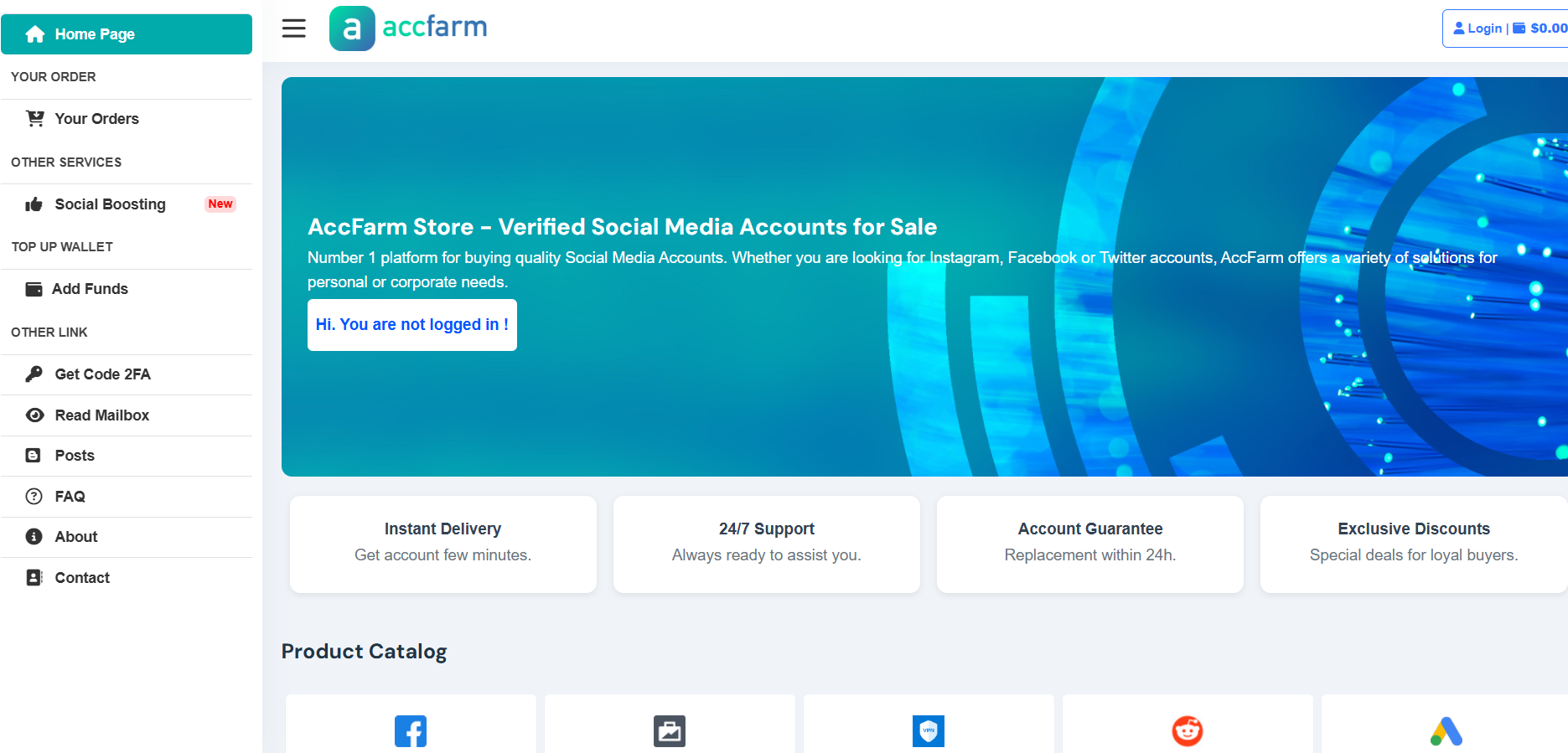
AccFarm Store is a platform that offers verified social media accounts across various platforms, including Facebook, Instagram, Twitter, LinkedIn, and more. Their services cater to individuals and businesses seeking established accounts with pre-built followers and engagement to facilitate marketing and outreach efforts.
Pros:
- Wide selection of accounts across multiple platforms.
- Instant access after purchase.
- 24/7 customer support.
- Replacement within 24 hours if issues occur.
Cons:
- Some users have reported inconsistencies in account quality, with occasional issues such as accounts being banned or reset shortly after purchase.
- Pricing can be higher depending on platform and follower count.
User reviews: Mixed. Some users report positive experiences with fast delivery and responsive support, while others have encountered issues with account bans and unresponsive customer service.
How to manage multiple LinkedIn accounts with Multilogin
If you want to manage multiple LinkedIn accounts, you need to keep each session isolated, use dedicated IPs, and make profiles feel like real users. Multilogin makes managing multiple LinkedIn accounts simple.
You can watch our video here:
https://www.youtube.com/watch?v=MFGKol32DO0
1. Sign up and log in
Create a Multilogin account and start the 3-day trial (€1.99) to test core features and up to 5 profiles. If you like it, upgrade to a paid plan — basic plans start from around €9/month for the smaller profile bundles. Choose cloud or local storage depending on whether you want session access from multiple machines.
2. Create a profile on the Dashboard
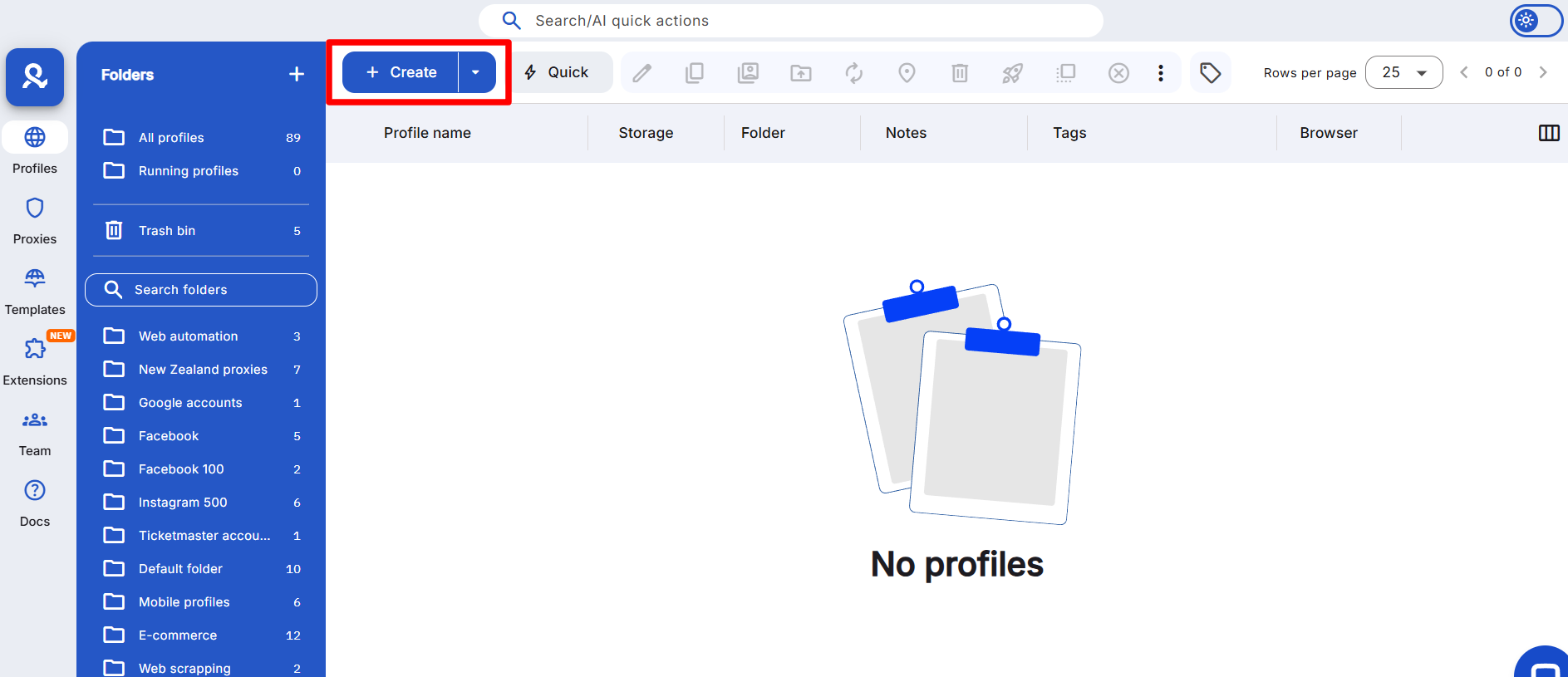
Open the Multilogin dashboard and click Create. Each Multilogin profile represents one browser environment (one LinkedIn account). Think of it as a virtual device you’ll log LinkedIn into.
3. Enter the name, select the proxy location
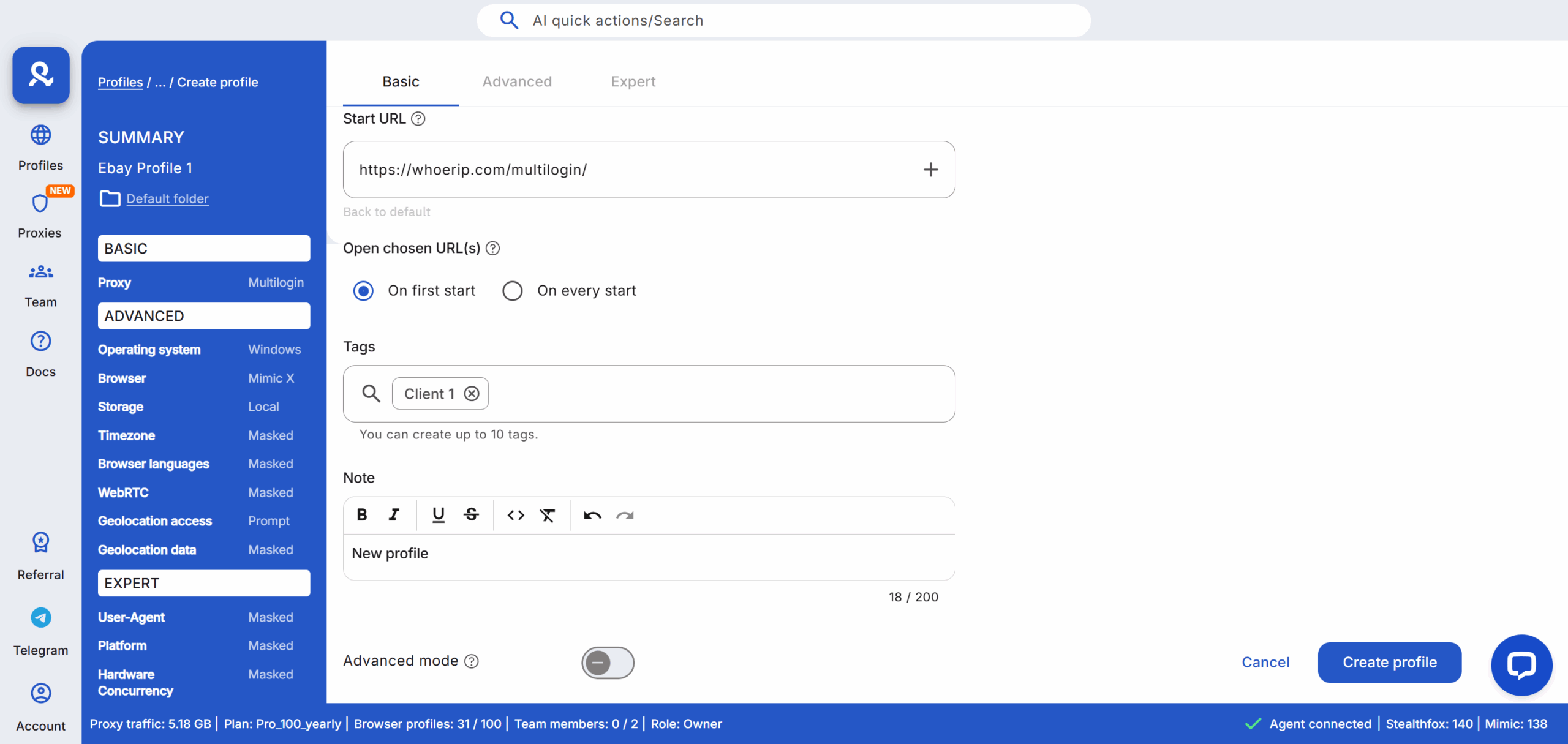
Give the profile a clear name (e.g., Sales_US_East_01). Pick a proxy location that matches the account’s claimed geography — country and city — to avoid location mismatches that trigger LinkedIn checks. Multilogin has built-in residential proxy options, which you can assign per profile.
4. Use tags and notes
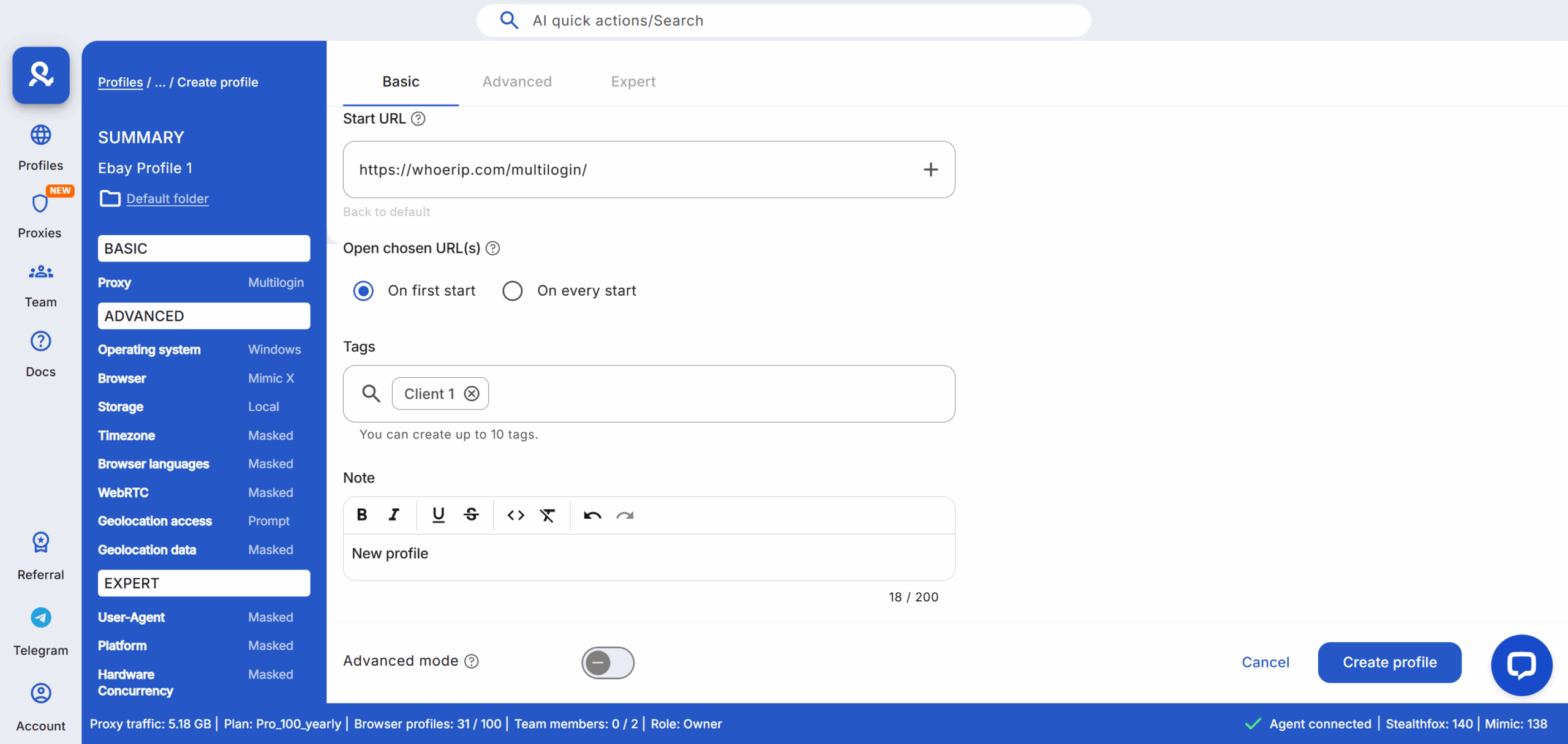
Use tags (e.g., client-A, recruiter, aged-PVA) and add notes in the profile metadata for important details (phone verified, birthdate used, connection strategy). Tags are invaluable when you scale to dozens or hundreds of profiles.
5. Configure additional fingerprint parameters
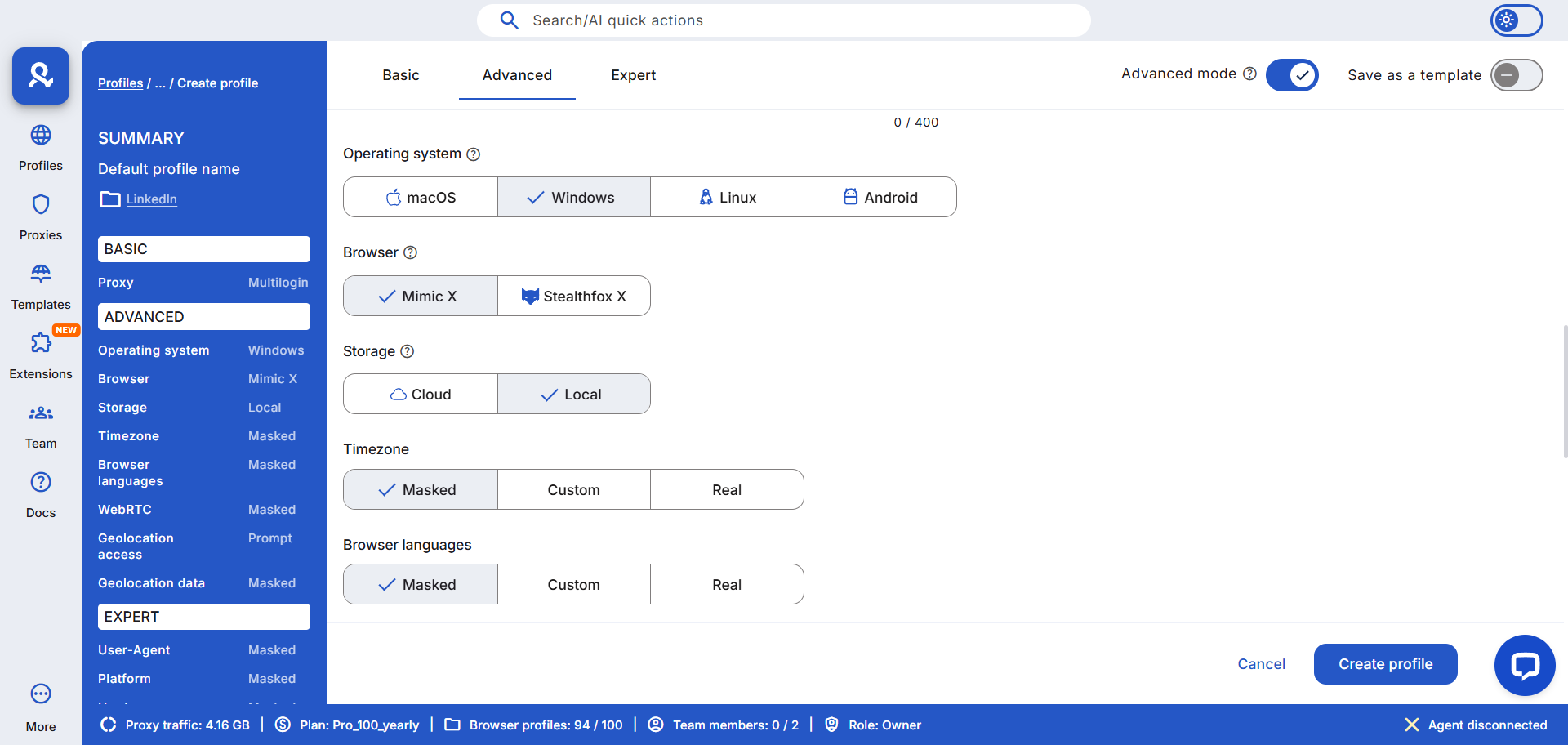
Customize device parameters — user agent, screen resolution, timezone, language, WebGL, audio/video devices and timezone — to match the persona you plan to use. Avoid default or obviously synthetic combinations; aim for consistent, realistic settings that match the proxy location.
6. Save your profile by clicking Create
Once settings look realistic, save the profile. If you need multiple similar profiles, create one “template” then use cloning (next step) rather than manually repeating steps — this reduces setup time and human error.
7. Launch the profile and log in
Launch the isolated browser for that profile and sign into the corresponding LinkedIn account. Complete any required security checks (email, phone verification) while the profile is running under its assigned proxy and fingerprint — this ties the verification to the correct environment.
8. Use cloning or AI Actions to scale
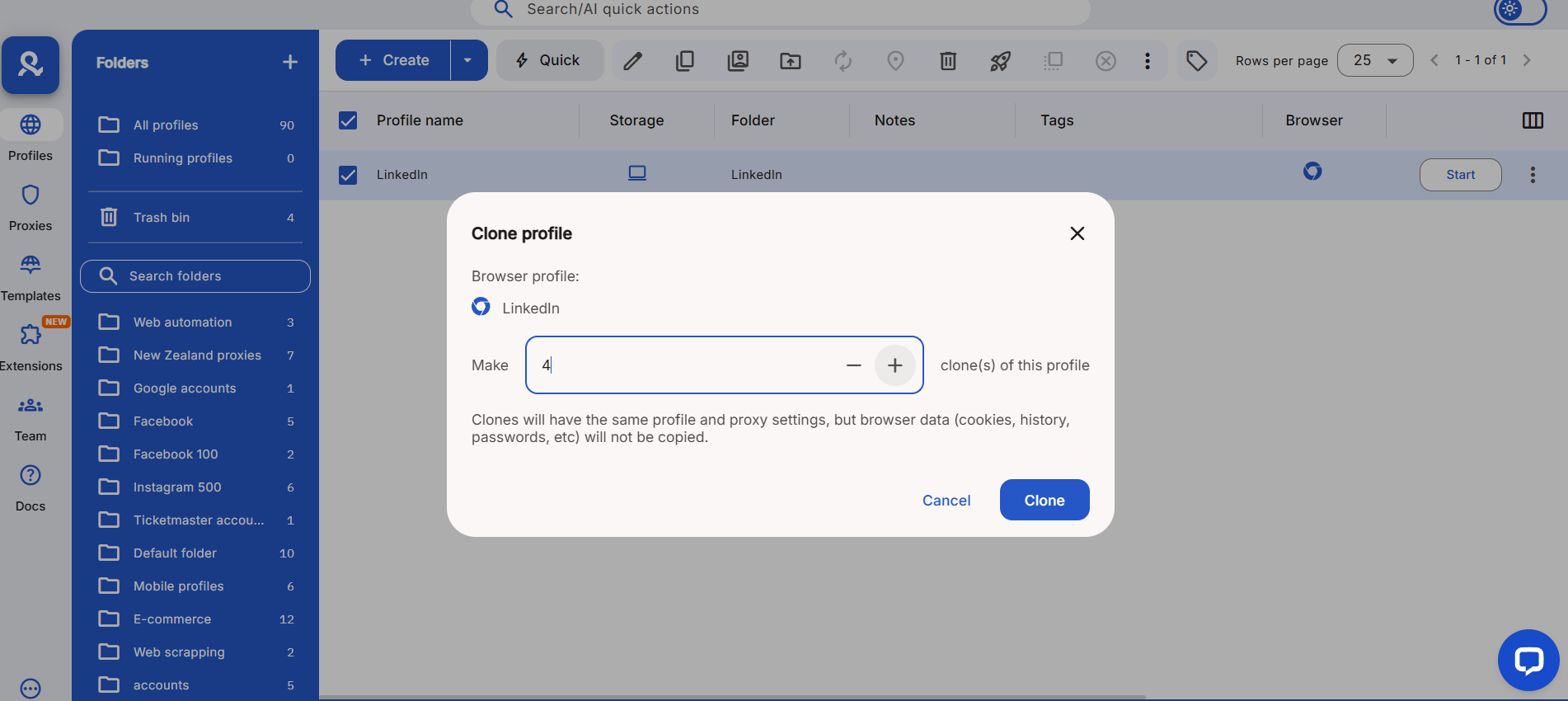
Multilogin supports cloning profiles and advanced automation (AI Actions / scripts). Use cloning to create multiple profiles with the same baseline settings, then tweak unique identifiers (proxy, name, timezone) per clone.
For repetitive onboarding work (filling out profiles, accepting invites) consider AI Actions or automation integrations — but throttle actions and randomize timing to mimic human behavior.
9. Log in in each isolated environment
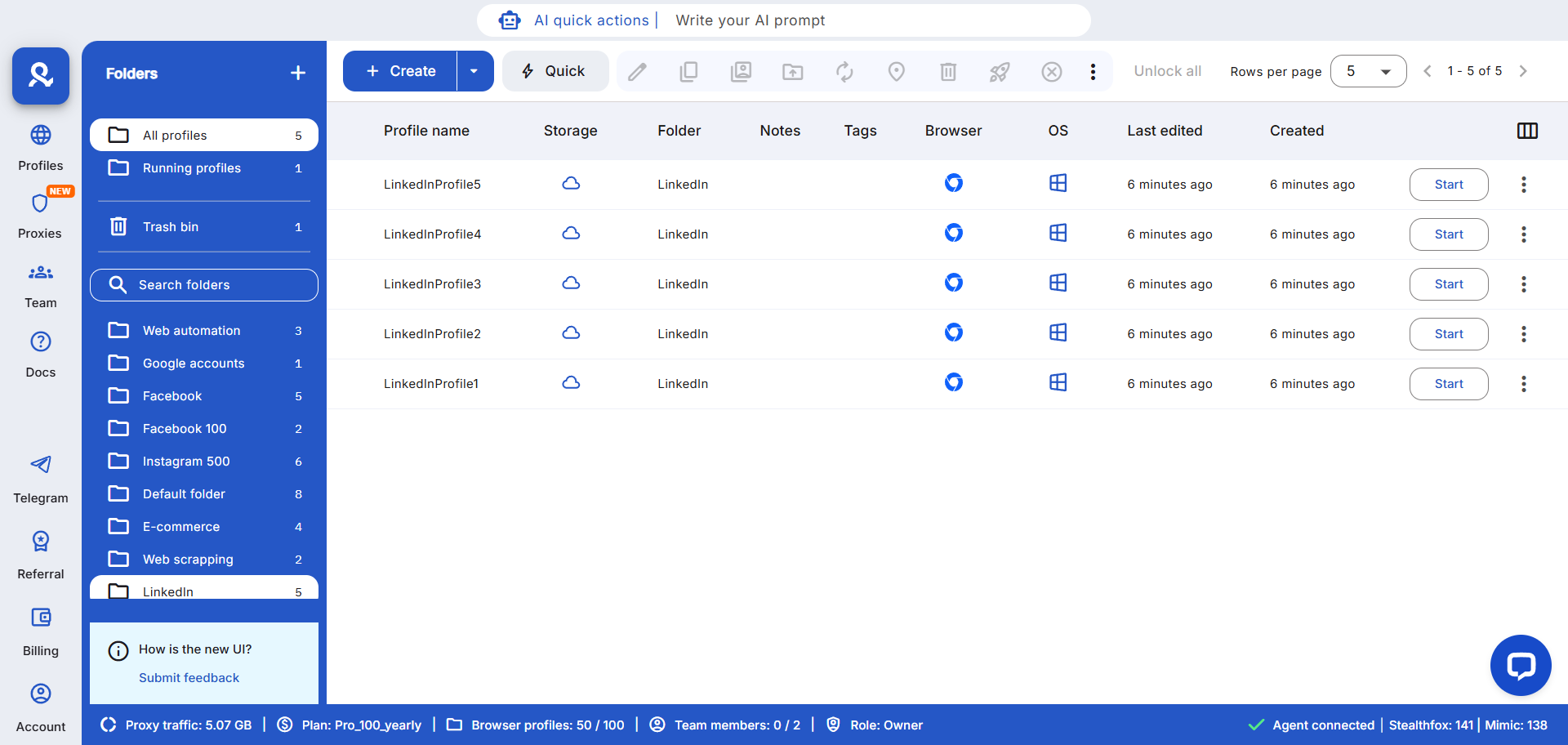
Always log each LinkedIn account only in its Multilogin profile. Never reuse cookies, local storage, or credentials across profiles. If you need to transfer cookies or sessions, use Multilogin’s export/import tools carefully and only when you understand the security tradeoffs.
10. Manage your accounts
- Daily ops: rotate tasks, limit connection/message volumes per profile, and schedule activity windows.
- Monitoring: track suspicious flags (verification prompts, limits, CAPTCHAs) and pause profiles showing abnormal behavior.
- Team access: share profiles with teammates via Multilogin’s team controls and permissioning rather than exposing raw credentials. Multilogin supports team seats and profile sharing so operations can scale without cross-contamination.
Who often buys LinkedIn accounts
While buying LinkedIn accounts carries significant risks, some professionals and businesses still use them in specific, carefully controlled scenarios where the benefits of scale, segmentation, or anonymity outweigh the potential downsides.
E-commerce and dropshipping startups
Entrepreneurs managing multiple e-commerce ventures may use separate LinkedIn profiles to segment audiences and marketing efforts. When used ethically, these accounts allow startups to engage with different market niches without confusing followers or clients. The key is to maintain professional management and focus on genuine engagement.
Digital marketing agencies
Agencies handling campaigns for multiple clients often need to manage high volumes of outreach. Purchased accounts can help test strategies or manage campaign volumes without putting a client’s primary account at risk. Ethical usage requires transparency and clear attribution, such as noting that the profiles are agency-managed for specific campaigns.
HR, staffing, and recruitment firms
Recruiters frequently hit LinkedIn’s weekly limits on messages and connection requests. Multiple accounts can expand their reach and allow access to a wider talent pool. The accounts must be used responsibly, for genuine outreach, not spam or deceptive tactics.
B2B service providers
Companies focused on rapid outreach, lead generation, or market research may use supplementary accounts to support initial contact efforts. Success depends on integrating these accounts into an ethical sales or research strategy, ensuring they do not replace authentic connections or engagement.
Why consider buying LinkedIn accounts
The decision to buy LinkedIn accounts often comes from a need to accelerate growth, scale outreach, and overcome the slow start of building a new profile. While LinkedIn’s terms discourage account trading, many marketers, recruiters, and agencies view it as a practical shortcut for expanding operations. Understanding these motivations helps explain why the demand for LinkedIn accounts—especially aged and verified ones—continues to grow.
- Instant network growth
One of the strongest motivations is the ability to gain immediate visibility. Building a professional network from scratch can take months or even years. Purchased aged accounts often come with existing connections, active histories, and engagement patterns that give new users a head start.
This can be especially useful for:
- Startups aiming to establish credibility in competitive industries.
- Sales and lead generation teams need to bypass connection limits and reach broader audiences quickly.
- Recruiters seeking faster access to talent pools without waiting for gradual organic growth.
- Time-saving compared to organic growth
Organic growth on LinkedIn requires consistent posting, commenting, and relationship-building—an approach that demands significant time and patience. Buying ready-made accounts allows users to skip the early grind and immediately focus on outreach, campaign execution, or content promotion. The saved time can then be invested in strategic business activities instead of profile nurturing.
- Established profiles with work history, skills, and endorsements
High-quality aged accounts often include complete profiles—work experience, education, endorsements, and connections—making them appear authentic and trustworthy. Such established profiles lend instant credibility and are valuable for managing multiple brands, testing marketing campaigns, or representing different clients through distinct professional personas.
- Bypassing account restrictions and limits
LinkedIn imposes strict limits on new accounts, including daily connection requests, messaging caps, and visibility restrictions. Aged accounts typically have fewer of these limitations, allowing more flexibility and freedom of activity. This makes them ideal for outreach automation, lead generation, and data collection tasks where scale and consistency are essential.
- Potential for increased reach and wider content sharing
With multiple purchased accounts, the ability to amplify content reach and sharing increases significantly. This strategy can be employed to:
This strategy can be employed to boost content visibility, as sharing posts from multiple accounts can increase their initial engagement, pushing them higher in LinkedIn’s algorithm. It also supports targeted campaigns by deploying accounts within specific niches to spread targeted messages to relevant audiences.
Run multiple LinkedIn accounts
Conclusion
Buying LinkedIn accounts can speed outreach and expand networks, but it carries risks like account suspension and legal issues. Choose trusted sellers, check account quality, and isolate each account using tools like Multilogin. Use accounts responsibly, follow real user patterns, and monitor activity. Purchased accounts can support outreach, but real engagement and consistent use remain essential for growth.
How to buy LinkedIn accounts in 2025: FAQ
Buying LinkedIn accounts carries significant risks. LinkedIn strictly prohibits account trading in its User Agreement, and purchased profiles may be flagged, restricted, or permanently banned. To reduce risks, use account isolation tools like Multilogin, unique fingerprints, and dedicated proxies when managing multiple accounts.
When you buy aged LinkedIn accounts or buy old LinkedIn accounts, you gain:
- Instant credibility with established connections and work history
- Higher trust and deliverability for messaging and connection requests
- Ability to scale outreach faster without waiting for new profiles to age
To buy verified LinkedIn accounts or buy verified LinkedIn account, focus on:
- Trusted sellers with positive reviews and transparent processes
- Accounts with real connections, phone verification (PVA), and proper activity history
- Using tools like Multilogin to isolate each account and avoid LinkedIn detection
Before you buy LinkedIn account or buy aged LinkedIn account, verify:
- Account age and number of real connections
- Profile verification (phone/email) and activity consistency
- Seller reputation and replacement policies
- Compatibility with automation or management tools
There are several platforms to buy aged LinkedIn accounts safely, including MirrorProfiles, LinkUnity, UseViral, and Akountify. Always conduct your own due diligence to ensure account authenticity and follow ethical practices.
Yes. If LinkedIn detects links between your purchased accounts and your main profile (shared devices, cookies, or IPs), your primary account may be restricted or banned. Always use account isolation practices to mitigate this risk.
- Aged LinkedIn accounts: Older profiles with established connections, work history, and higher trust. Better for scaling outreach safely.
- New accounts: Freshly created, more likely to face limitations, and require time to build credibility.
Use tools like Multilogin to:
- Isolate each account in a separate browser environment
- Assign dedicated IPs and proxies per account
- Monitor activity, rotate tasks, and prevent cross-detection
Yes. Buying LinkedIn accounts may violate LinkedIn’s User Agreement and, in some cases, data protection laws if the account contains someone else’s information. Always prioritize ethical usage, secure account sources, and avoid misrepresentation.
When done responsibly, buying LinkedIn accounts or buying LinkedIn aged account can accelerate outreach, expand networks, and save time compared to organic growth. However, long-term success still relies on authentic engagement, careful account management, and ethical practices.
- Use unique fingerprints and browser isolation for each account
- Assign country-specific proxies matching the account’s location
- Avoid sharing credentials outside of secure management tools
- Monitor for LinkedIn verification prompts and unusual activity
Yes. Businesses, agencies, and recruiters often buy verified LinkedIn accounts or buy aged LinkedIn accounts to manage outreach safely at scale. Always implement isolation, rotation, and ethical usage policies to protect accounts and your main profile.
